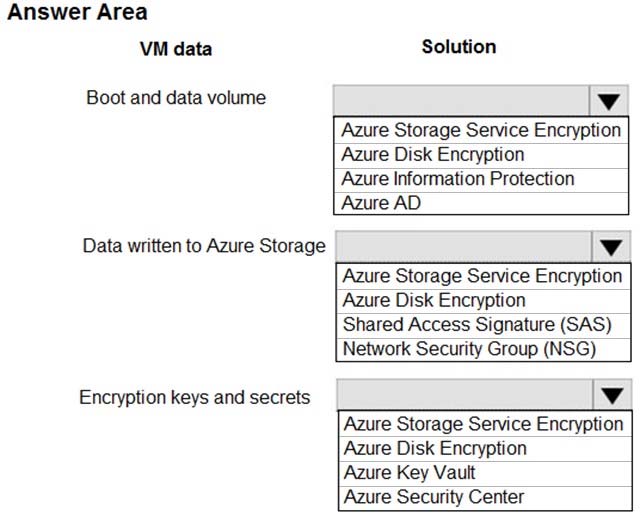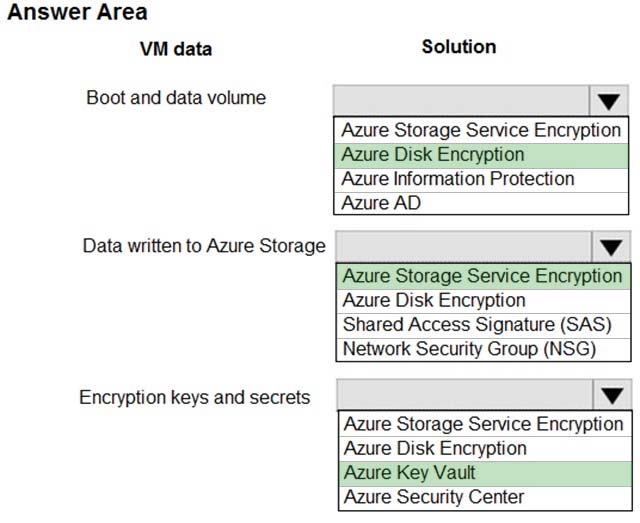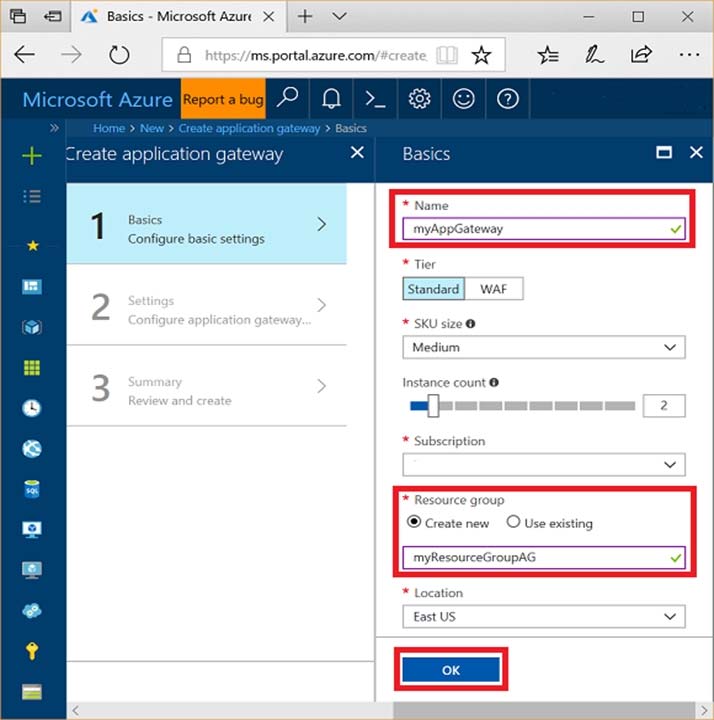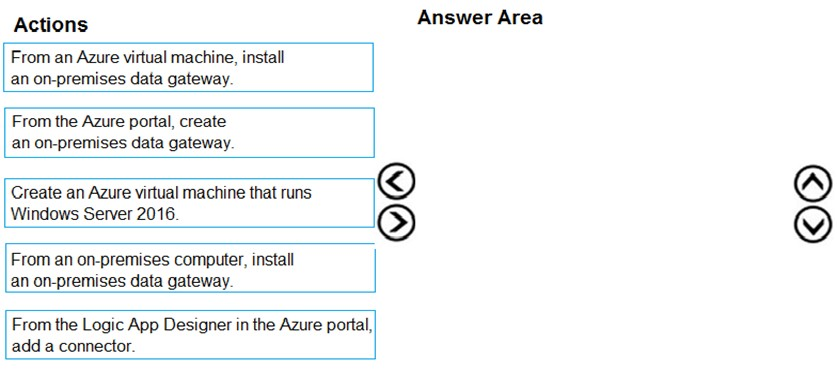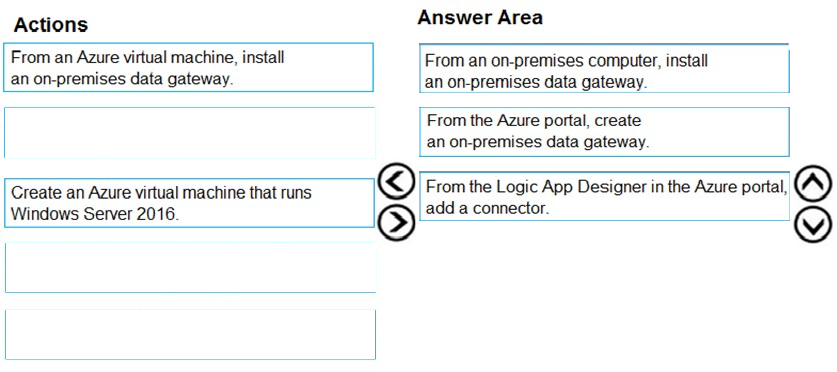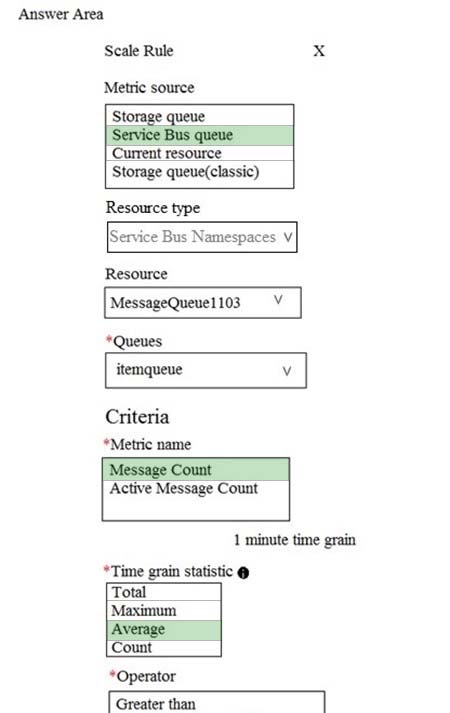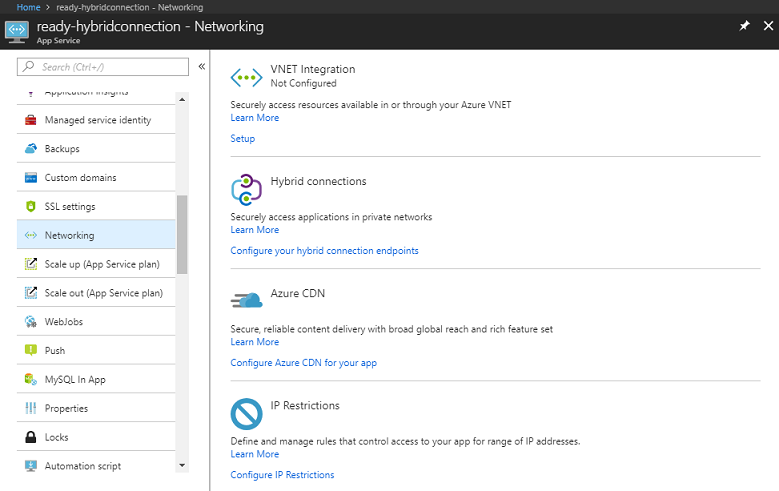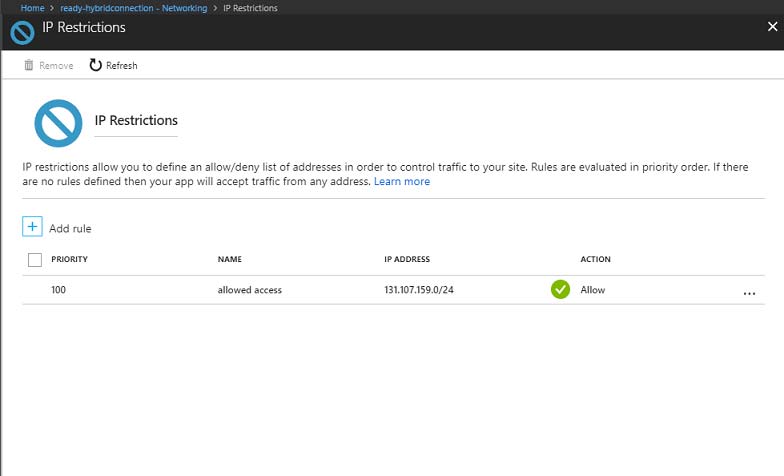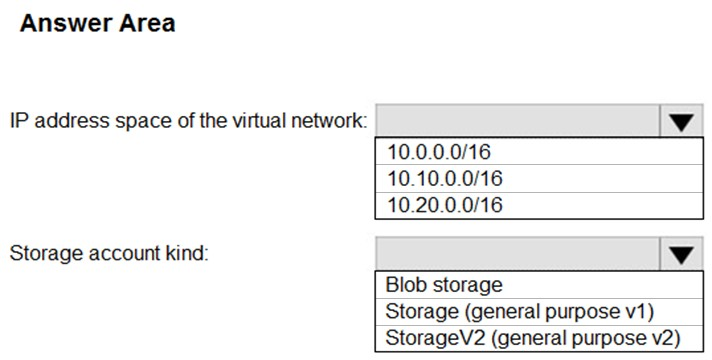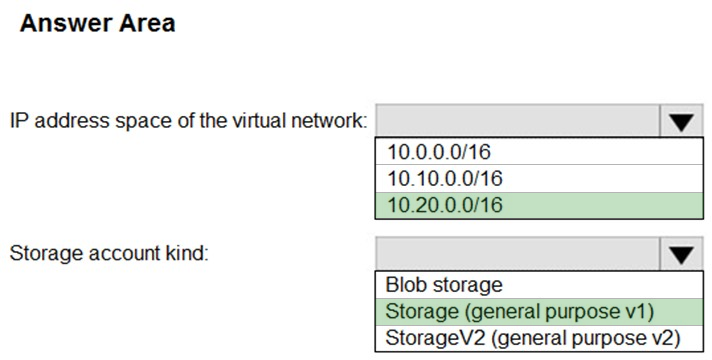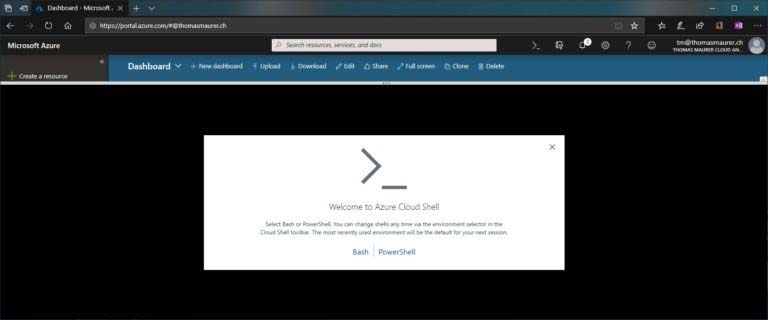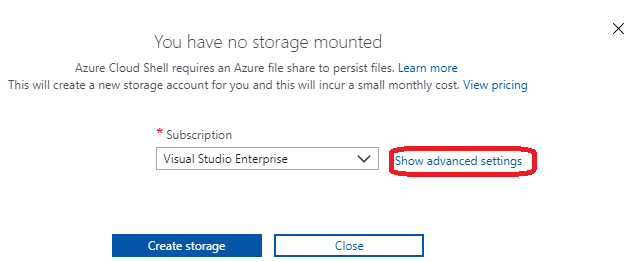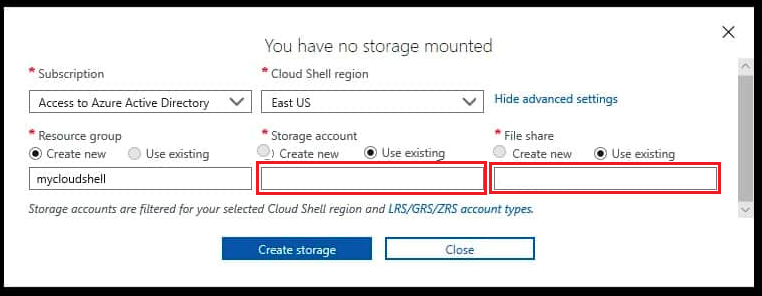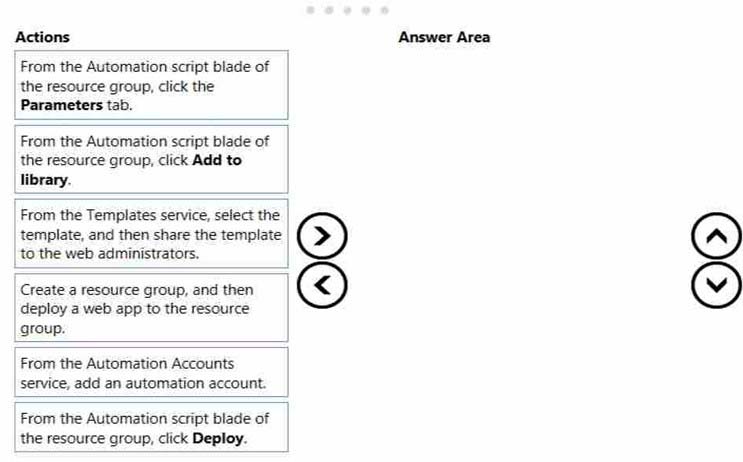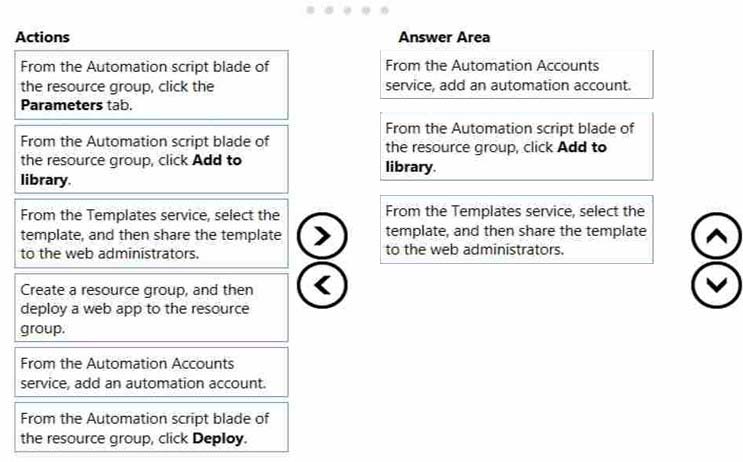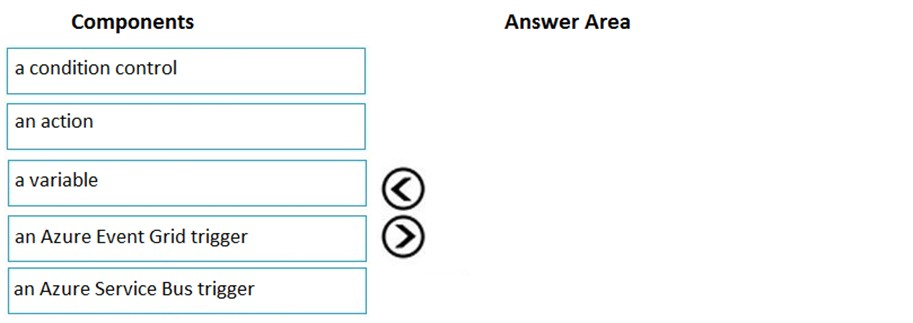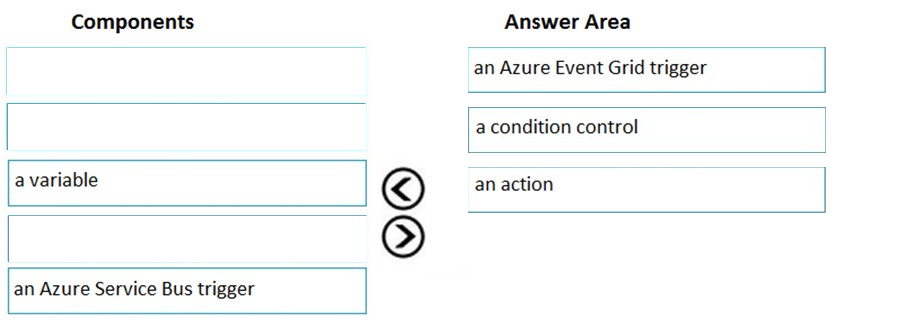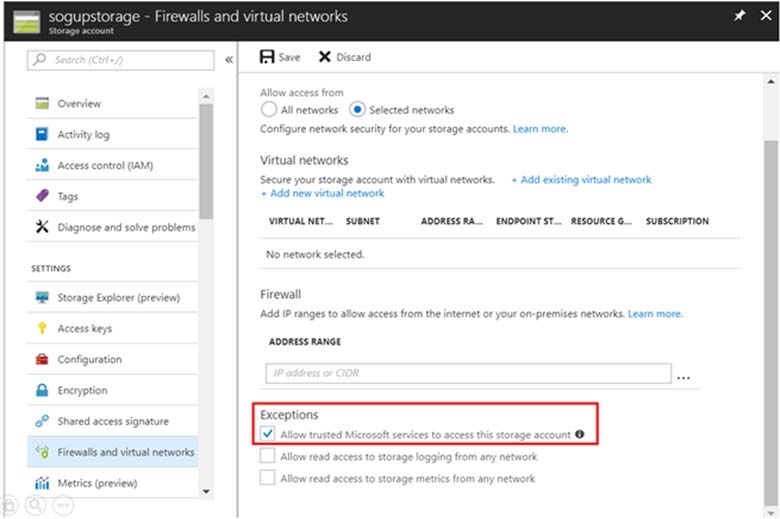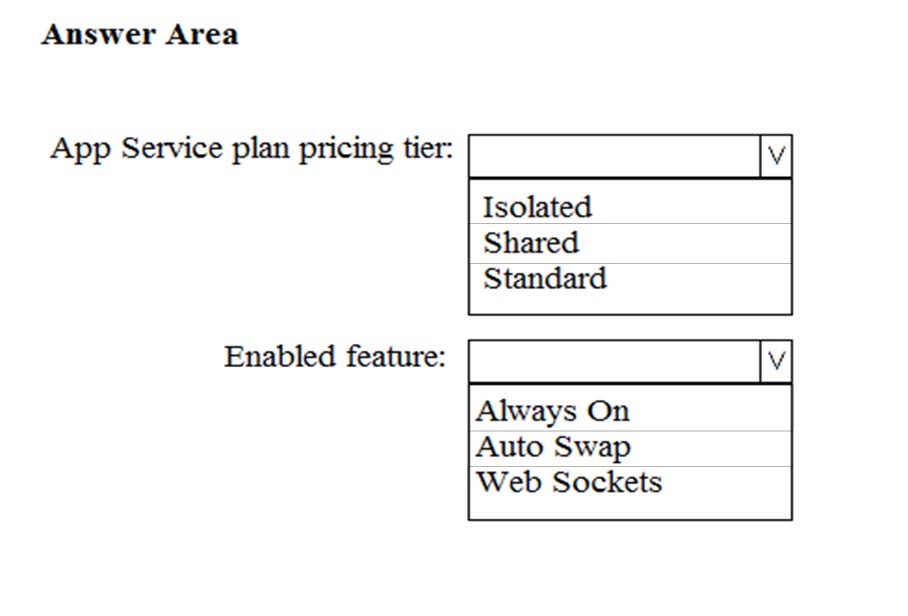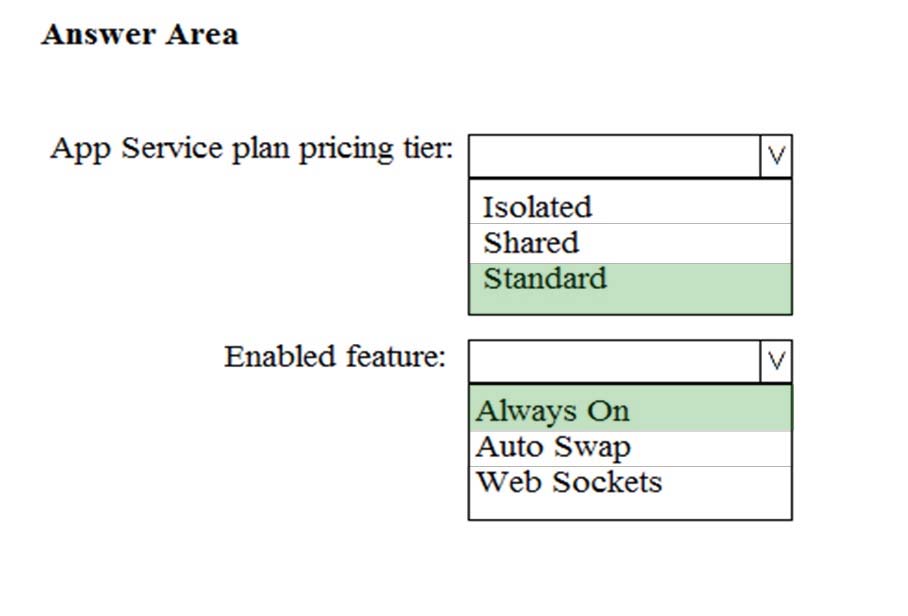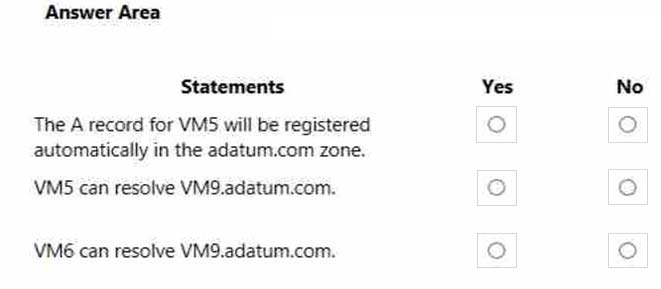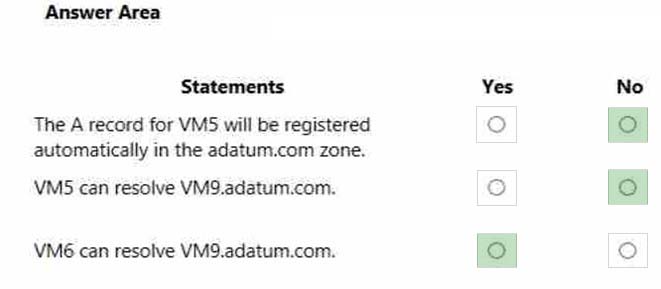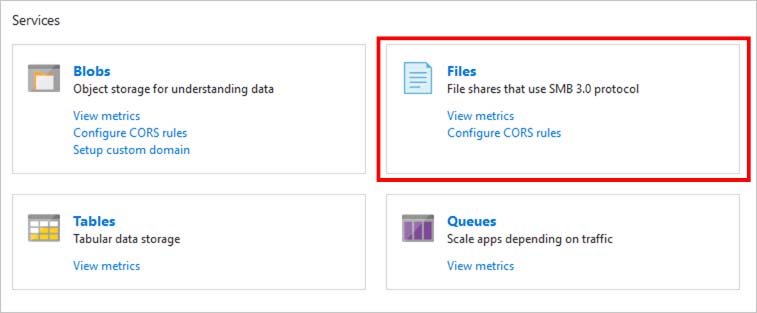AZ-300 Practice Questions Free – 50 Exam-Style Questions to Sharpen Your Skills
Are you preparing for the AZ-300 certification exam? Kickstart your success with our AZ-300 Practice Questions Free – a carefully selected set of 50 real exam-style questions to help you test your knowledge and identify areas for improvement.
Practicing with AZ-300 practice questions free gives you a powerful edge by allowing you to:
- Understand the exam structure and question formats
- Discover your strong and weak areas
- Build the confidence you need for test day success
Below, you will find 50 free AZ-300 practice questions designed to match the real exam in both difficulty and topic coverage. They’re ideal for self-assessment or final review. You can click on each Question to explore the details.
HOTSPOT - Your company runs several Windows and Linux virtual machines (VMs). You must design a solution that implements data privacy, compliance, and data sovereignty for all storage uses in Azure. You plan to secure all Azure storage accounts by using Role-Based Access Controls (RBAC) and Azure Active Directory (Azure AD). You need to secure the data used by the VMs. Which solution should you use? To answer, select the appropriate solutions in the answer area. NOTE: Each correct selection is worth one point. Hot Area:
SIMULATION - Click to expand each objective. To connect to the Azure portal, type https://portal.azure.com in the browser address bar.
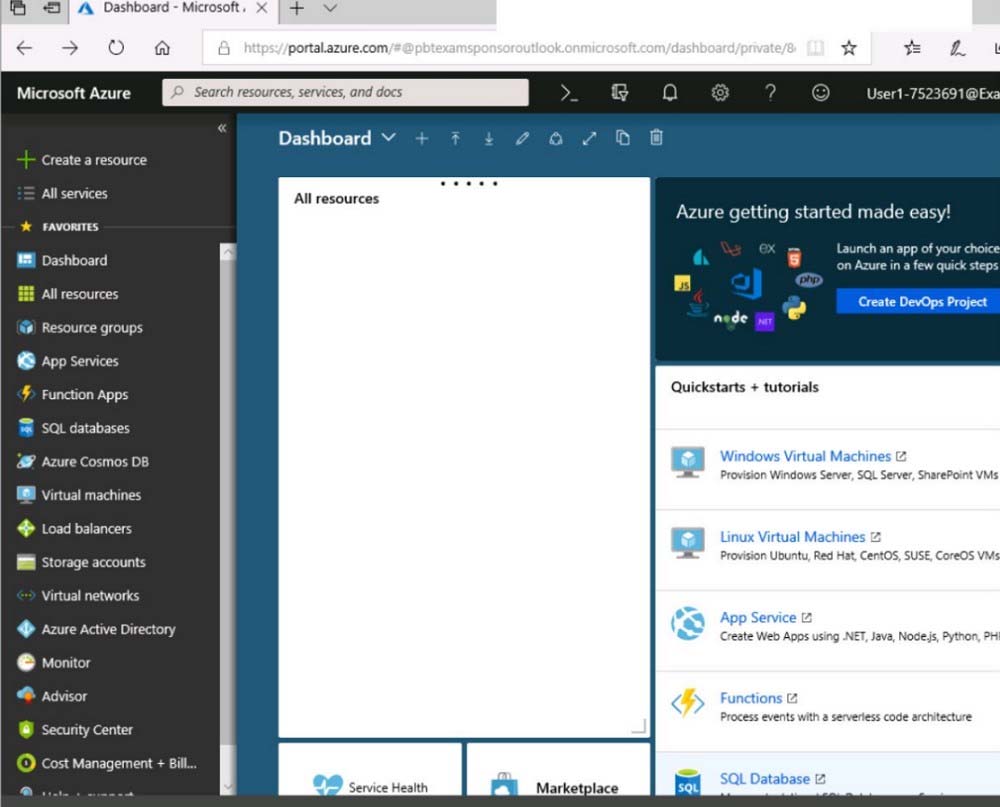
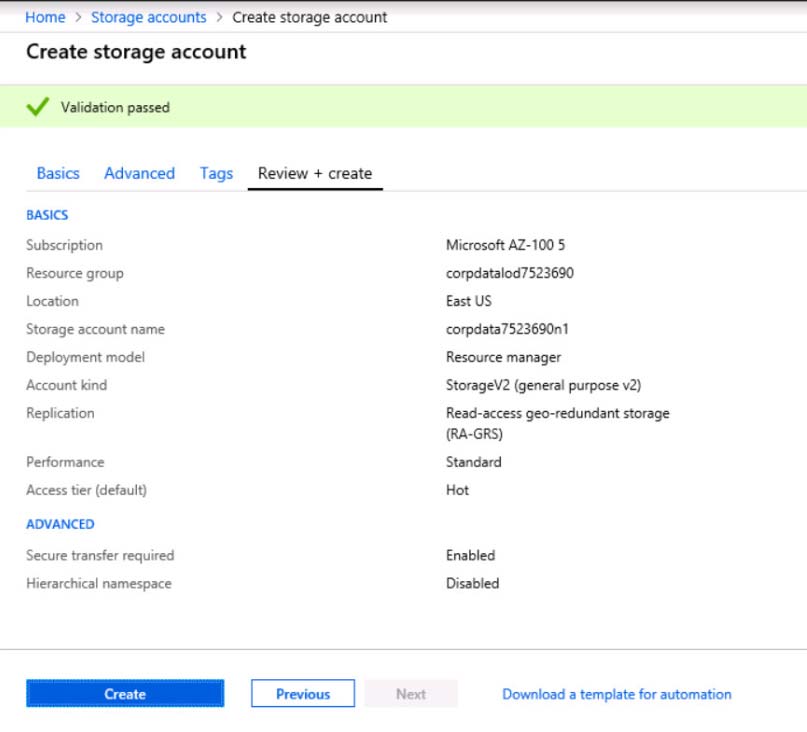
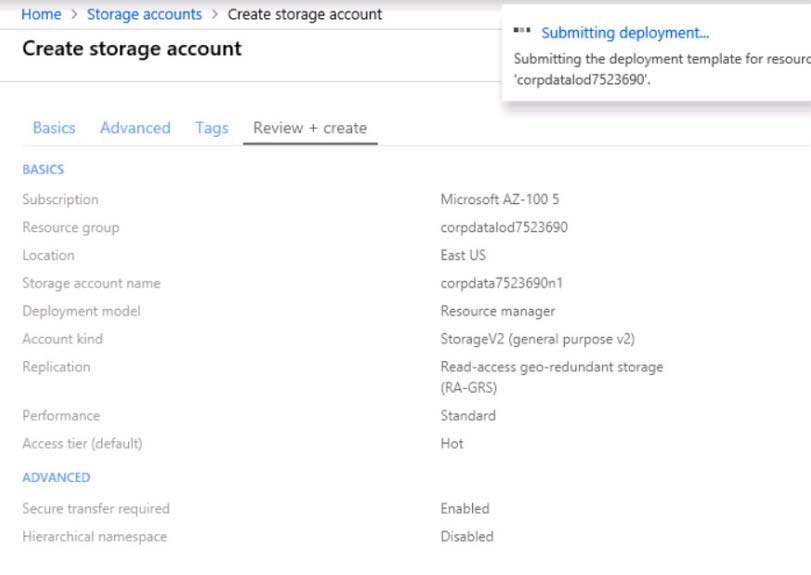

When you are finished performing all the tasks, click the "˜Next' button. Note that you cannot return to the lab once you click the "˜Next' button. Scoring occur in the background while you complete the rest of the exam. Overview - The following section of the exam is a lab. In this section, you will perform a set of tasks in a live environment. While most functionality will be available to you as it would be in a live environment, some functionality (e.g., copy and paste, ability to navigate to external websites) will not be possible by design. Scoring is based on the outcome of performing the tasks stated in the lab. In other words, it doesn't matter how you accomplish the task, if you successfully perform it, you will earn credit for that task. Labs are not timed separately, and this exam may have more than one lab that you must complete. You can use as much time as you would like to complete each lab. But, you should manage your time appropriately to ensure that you are able to complete the lab(s) and all other sections of the exam in the time provided. Please note that once you submit your work by clicking the Next button within a lab, you will NOT be able to return to the lab. To start the lab - You may start the lab by clicking the Next button. You need to deploy an application gateway named appgw1015 to meet the following requirements: ✑ Load balance internal IP traffic to the Azure virtual machines connected to subnet0. ✑ Provide a Service Level Agreement (SLA) of 99,99 percent availability for the Azure virtual machines. What should you do from the Azure portal?
DRAG DROP - You have an on-premises network that includes a Microsoft SQL Server instance named SQL1. You create an Azure Logic App named App1. You need to ensure that App1 can query a database on SQL1. Which three actions should you perform in sequence? To answer, move the appropriate actions from the list of actions to the answer area and arrange them in the correct order. Select and Place:
HOTSPOT - You need to prepare the environment to implement the planned changes for Server2. What should you do? To answer, select the appropriate options in the answer area. NOTE: Each correct selection is worth one point. Hot Area:
HOTSPOT - You are developing a back-end Azure App Service that scales based on the number of messages contained in a Service Bus queue. A rule already exists to scale up the App Service when the average queue length of unprocessed and valid queue messages is greater than 1000. You need to add a new rule that will continuously scale down the App Service as long as the scale up condition is not met. How should you configure the Scale rule? To answer, select the appropriate options in the answer area. NOTE: Each correct selection is worth one point. Hot Area:
SIMULATION - Click to expand each objective. To connect to the Azure portal, type https://portal.azure.com in the browser address bar.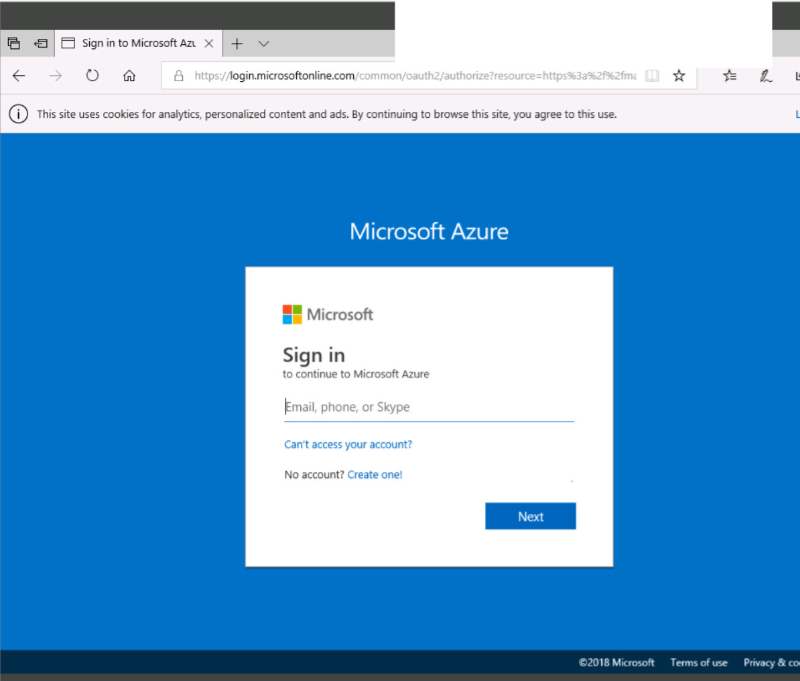
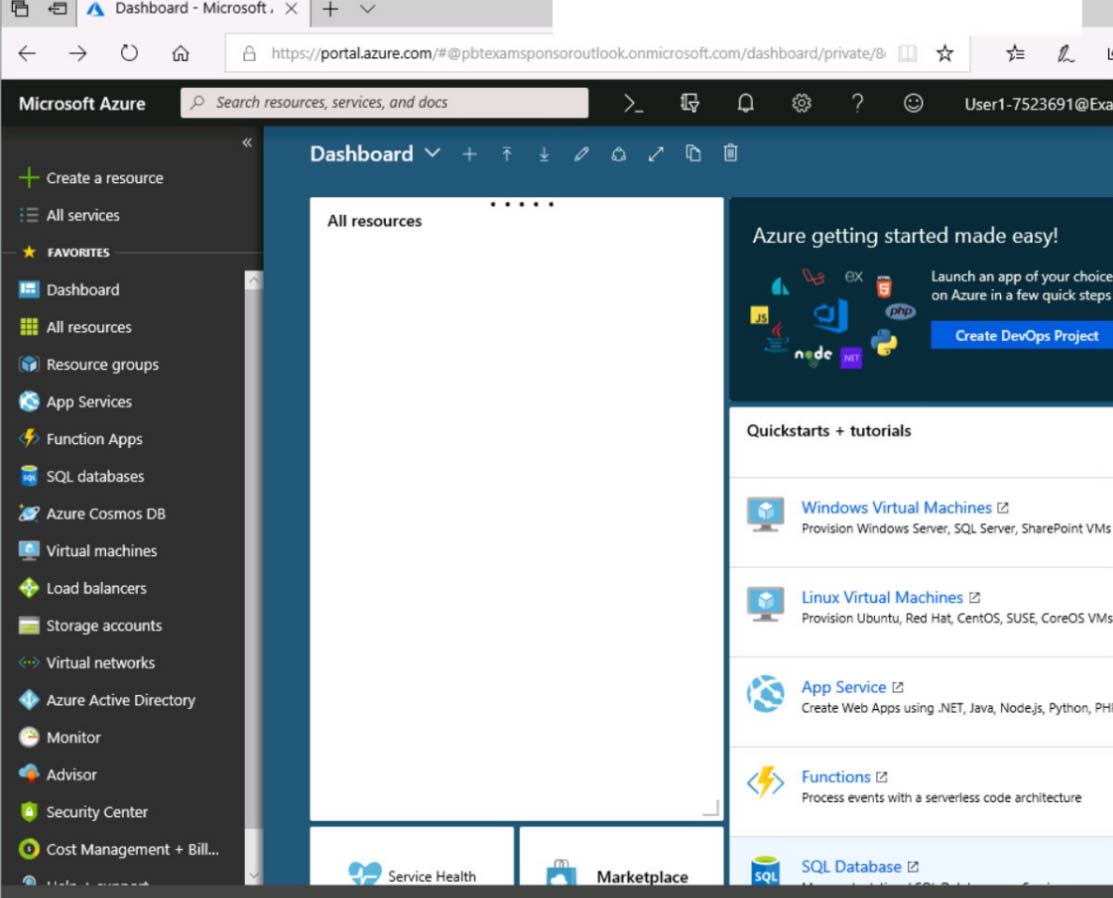
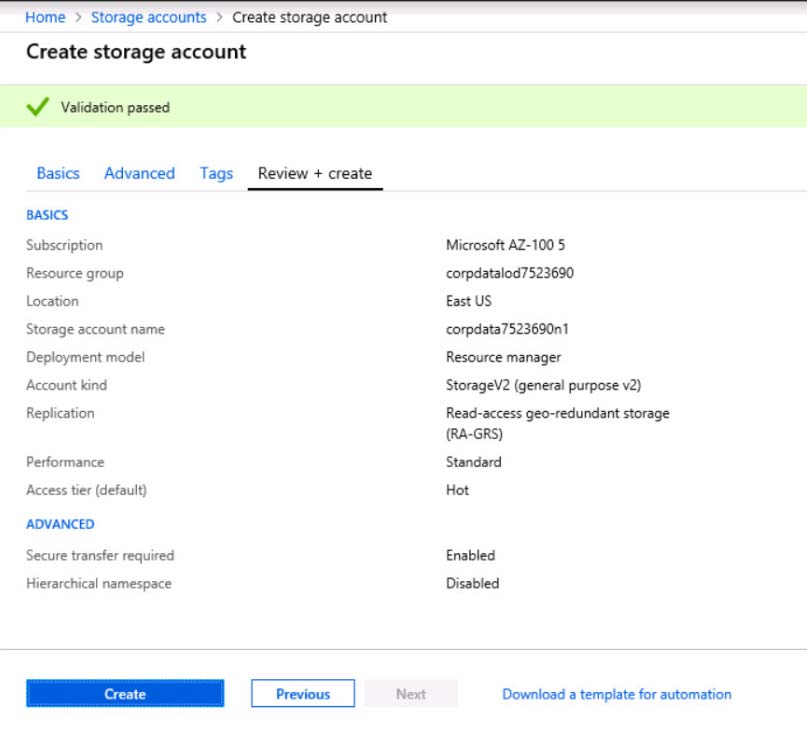
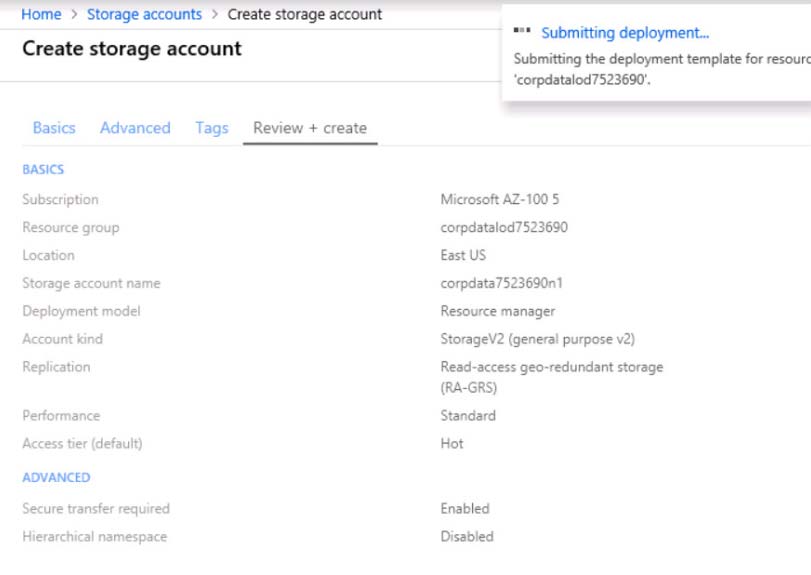
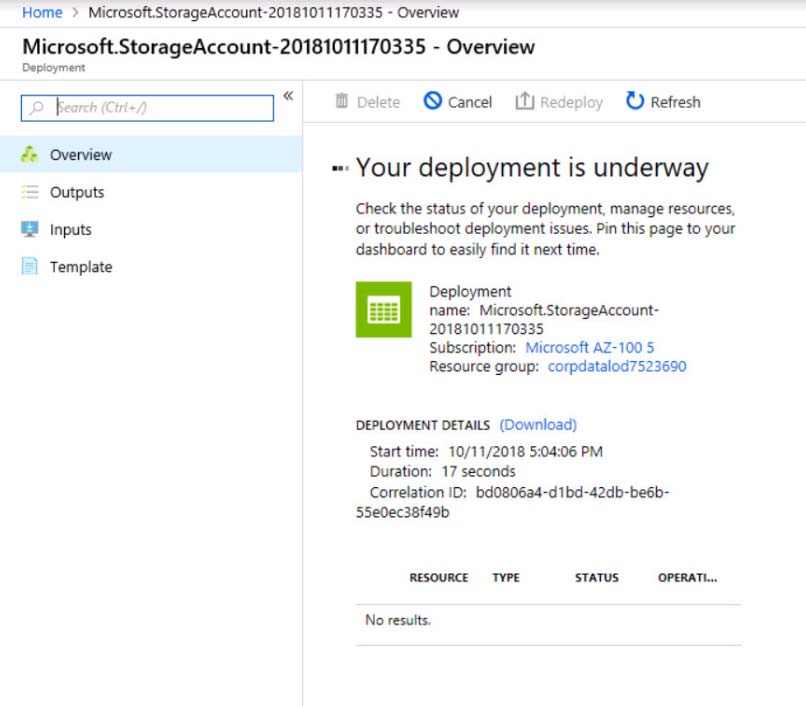
When you are finished performing all the tasks, click the "˜Next' button. Note that you cannot return to the lab once you click the "˜Next' button. Scoring occur in the background while you complete the rest of the exam. Overview - The following section of the exam is a lab. In this section, you will perform a set of tasks in a live environment. While most functionality will be available to you as it would be in a live environment, some functionality (e.g., copy and paste, ability to navigate to external websites) will not be possible by design. Scoring is based on the outcome of performing the tasks stated in the lab. In other words, it doesn't matter how you accomplish the task, if you successfully perform it, you will earn credit for that task. Labs are not timed separately, and this exam may have more than one lab that you must complete. You can use as much time as you would like to complete each lab. But, you should manage your time appropriately to ensure that you are able to complete the lab(s) and all other sections of the exam in the time provided. Please note that once you submit your work by clicking the Next button within a lab, you will NOT be able to return to the lab. To start the lab - You may start the lab by clicking the Next button. Another administrator reports that she is unable to configure a web app named corplod8548987n3 to prevent all connections from an IP address of 11.0.0.11. You need to modify corplod8548987n3 to successfully prevent the connections from the IP address. The solution must minimize Azure-related costs. What should you do from the Azure portal?
HOTSPOT - You need to provision the resources in Azure to support the virtual machine that will be migrated from the New York office. What should you include in the solution? To answer, select the appropriate options in the answer area. NOTE: Each correct selection is worth one point. Hot Area:
Note: This question is part of a series of questions that present the same scenario. Each question in the series contains a unique solution. Determine whether the solution meets the stated goals. You need to meet the vendor notification requirement. Solution: Configure notifications in the Azure API Management instance. Does the solution meet the goal?
A. Yes
B. No
You have a resource group named RG1. RG1 contains an Azure Storage account named storageaccount1 and a virtual machine named VM1 that runs Windows Server 2016. Storageaccount1 contains the disk files for VM1. You apply a ReadOnly lock to RG1. What can you do from the Azure portal?
A. Start VM1
B. Upload a blob to storageaccount1
C. View the keys of storageaccount1
D. generate an automation script for RG1
DRAG DROP - You have an Azure Active Directory (Azure AD) tenant that has the initial domain name. You have a domain name of contoso.com registered at a third-party registrar. You need to ensure that you can create Azure AD users that have names containing a suffix of @contoso.com. Which three actions should you perform in sequence? To answer, move the appropriate cmdlets from the list of cmdlets to the answer area and arrange them in the correct order. Select and Place:
A company is migrating an existing on-premises third-party website to Azure. The website is stateless. The company does not have access to the source code for the website. They have the original installer. The number of visitors at the website varies throughout the year. The on-premises infrastructure was resized to accommodate peaks but the extra capacity was not used. You need to implement a virtual machine scale set instance. What should you do -
A. Use a webhook to log autoscale failures.
B. Use an autoscale setting to scale instances vertically.
C. Use only default diagnostics metrics to trigger autoscaling
D. Use an autoscale setting to define more profiles that have one or more autoscale rules.
SIMULATION - Click to expand each objective. To connect to the Azure portal, type https://portal.azure.com in the browser address bar.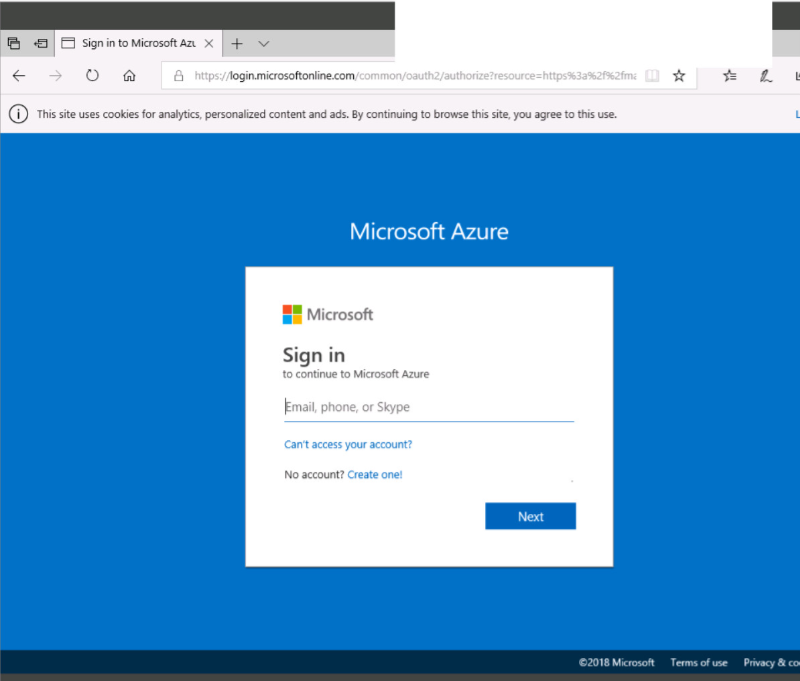
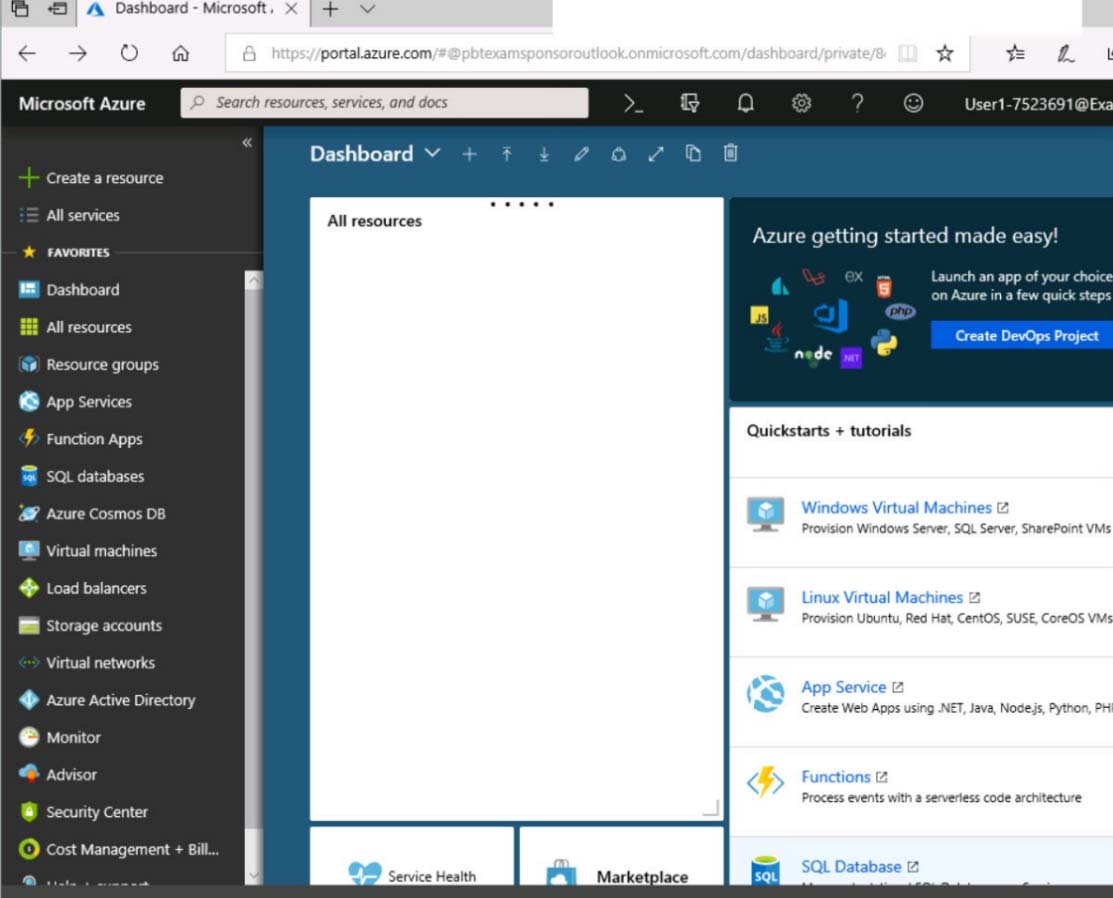
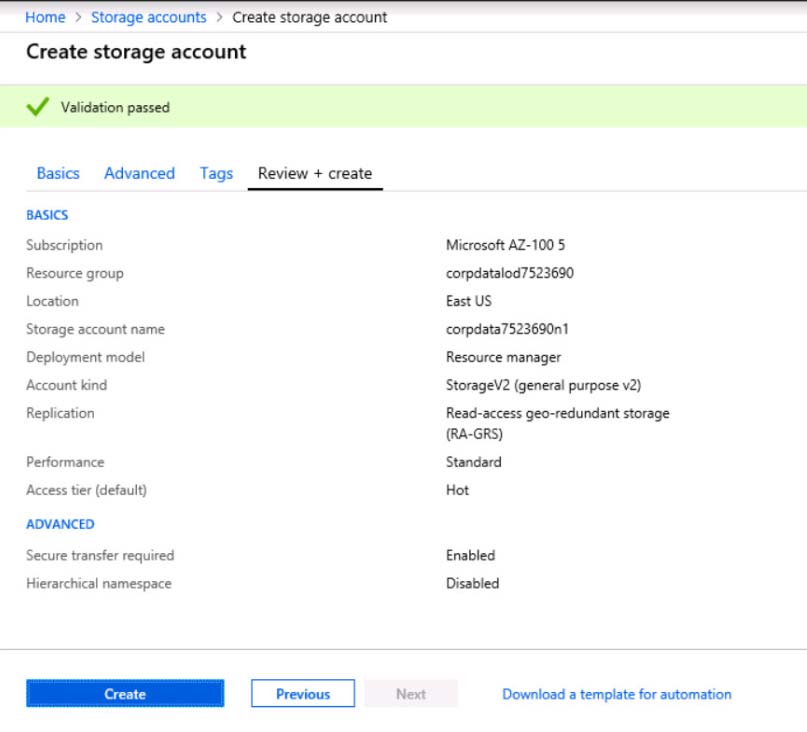
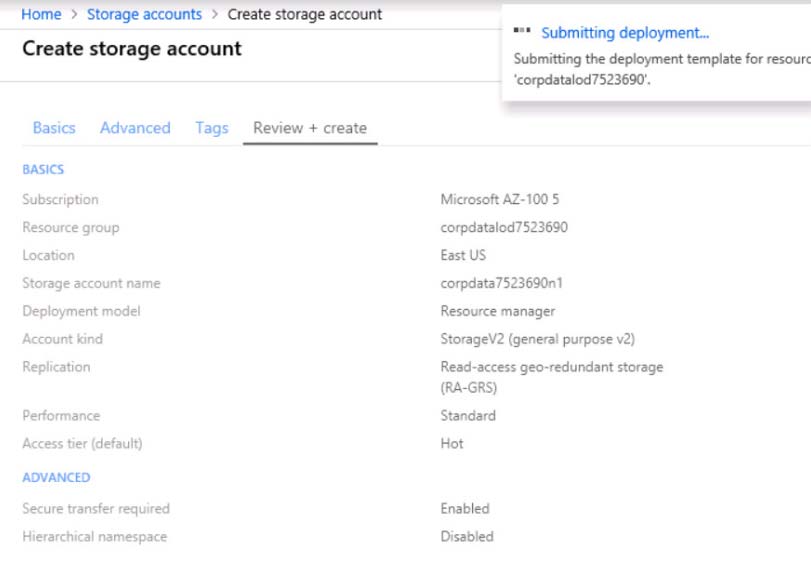

When you are finished performing all the tasks, click the "˜Next' button. Note that you cannot return to the lab once you click the "˜Next' button. Scoring occur in the background while you complete the rest of the exam. Overview - The following section of the exam is a lab. In this section, you will perform a set of tasks in a live environment. While most functionality will be available to you as it would be in a live environment, some functionality (e.g., copy and paste, ability to navigate to external websites) will not be possible by design. Scoring is based on the outcome of performing the tasks stated in the lab. In other words, it doesn't matter how you accomplish the task, if you successfully perform it, you will earn credit for that task. Labs are not timed separately, and this exam may have more than one lab that you must complete. You can use as much time as you would like to complete each lab. But, you should manage your time appropriately to ensure that you are able to complete the lab(s) and all other sections of the exam in the time provided. Please note that once you submit your work by clicking the Next button within a lab, you will NOT be able to return to the lab. To start the lab - You may start the lab by clicking the Next button. You plan to deploy several Azure virtual machines and to connect them to a virtual network named VNET1007. You need to ensure that future virtual machines on VNET1007 can register their name in an internal DNS zone named corp8548984.com. The zone must NOT be hosted on a virtual machine. What should you do from Azure Cloud Shell? To complete this task, start Azure Cloud Shell and select PowerShell (Linux), Click Show Advanced settings, and then enter corp8548984n1 in the Storage account text box and File1 share text box. Click Create storage, and then complete the task.
DRAG DROP - You maintain an existing Azure SQL Database instance. Management of the database is performed by an external party. All cryptographic keys are stored in an Azure Key Vault. You must ensure that the external party cannot access the data in the SSN column of the Person Table. Will each protection method meet the requirement? To answer, drag the appropriate responses to the correct protection methods. Each response may be used once, more than once, or not at all. You may need to drag the split bar between panes or scroll to view content. NOTE: Each correct selection is worth one point. Select and Place:
SIMULATION - Click to expand each objective. To connect to the Azure portal, type https://portal.azure.com in the browser address bar.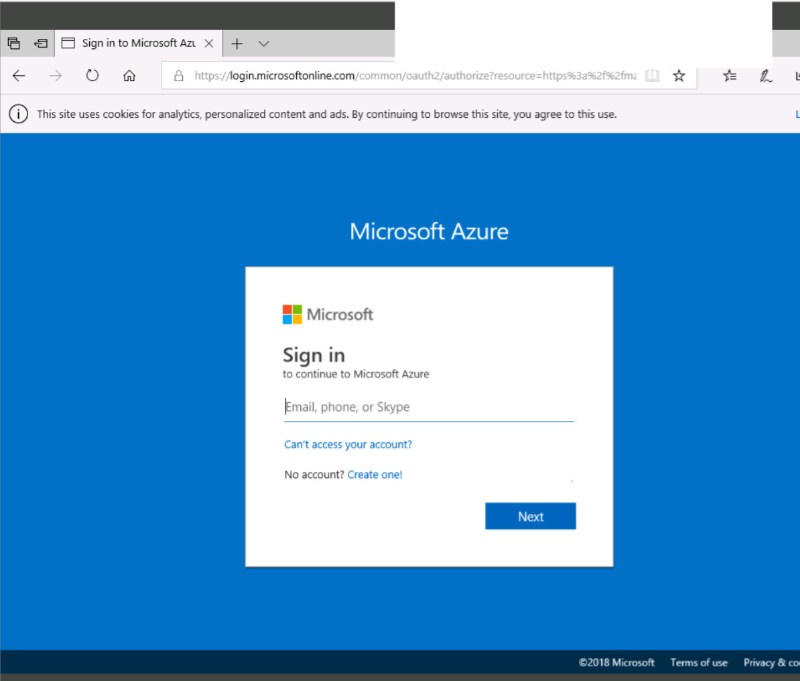
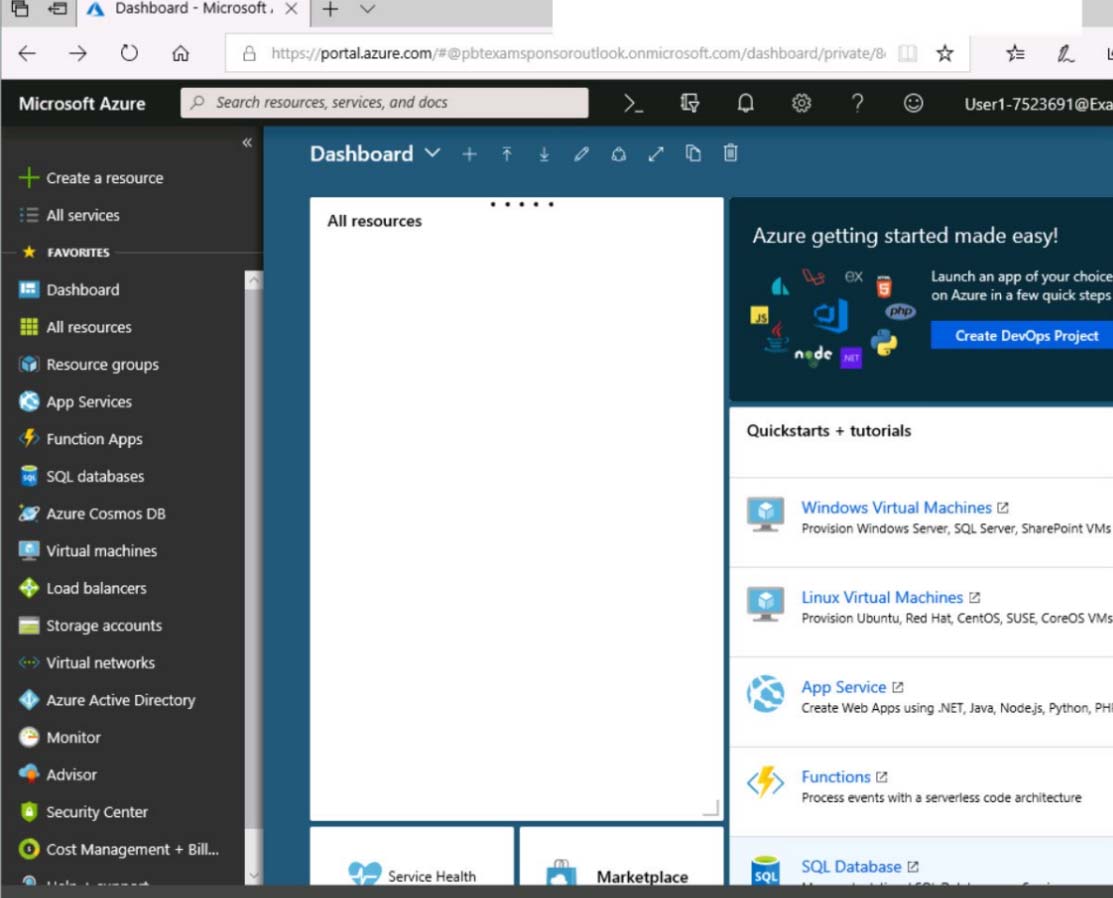
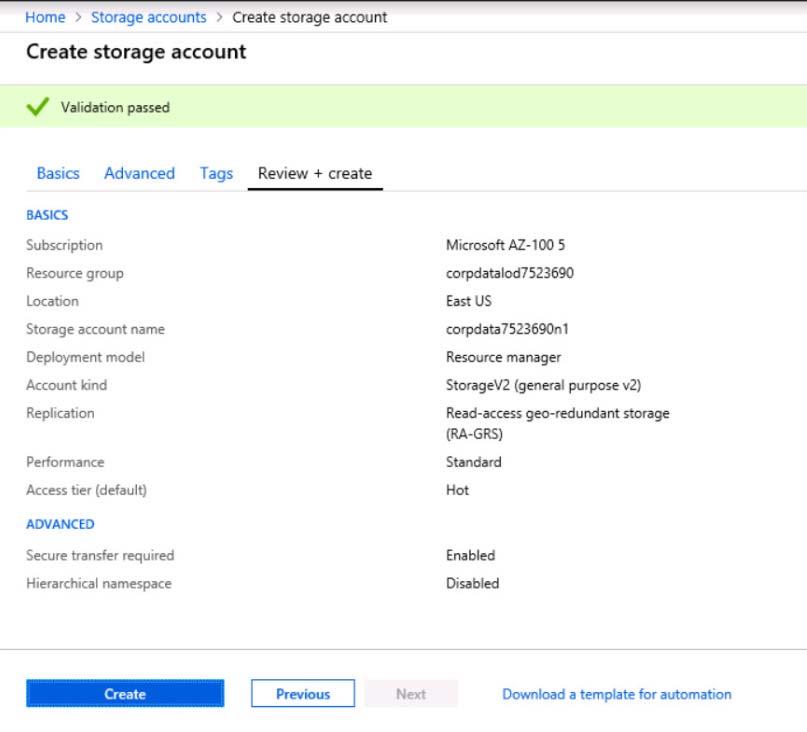

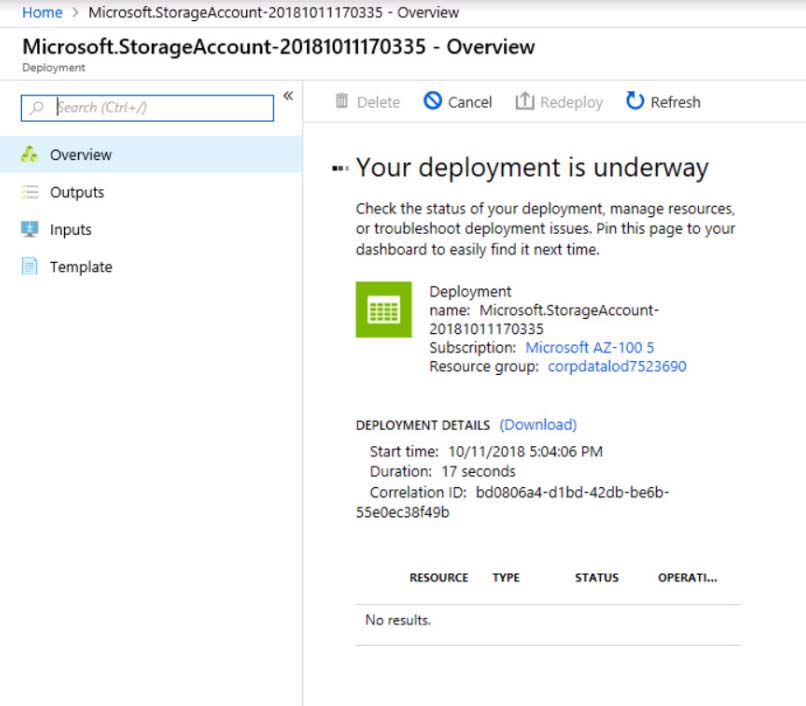
When you are finished performing all the tasks, click the "˜Next' button. Note that you cannot return to the lab once you click the "˜Next' button. Scoring occur in the background while you complete the rest of the exam. Overview - The following section of the exam is a lab. In this section, you will perform a set of tasks in a live environment. While most functionality will be available to you as it would be in a live environment, some functionality (e.g., copy and paste, ability to navigate to external websites) will not be possible by design. Scoring is based on the outcome of performing the tasks stated in the lab. In other words, it doesn't matter how you accomplish the task, if you successfully perform it, you will earn credit for that task. Labs are not timed separately, and this exam may have more than one lab that you must complete. You can use as much time as you would like to complete each lab. But, you should manage your time appropriately to ensure that you are able to complete the lab(s) and all other sections of the exam in the time provided. Please note that once you submit your work by clicking the Next button within a lab, you will NOT be able to return to the lab. To start the lab - You may start the lab by clicking the Next button. You need to deploy an Azure virtual machine named VM1004a based on an Ubuntu Server image, and then to configure VM1004a to meet the following requirements: - The virtual machines must contain data disks that can store at least 15 TB of data - The data disk must be able to provide at least 2,000 IOPS - Storage costs must be minimized What should you do from the Azure portal?
Note: This question is part of series of questions that present the same scenario. Each question in the series contains a unique solution that might meet the stated goals. Some question sets might have more than one correct solution, while others might not have a correct solution. After you answer a question in this section, you will NOT be able to return to it. As a result, these questions will not appear in the review screen. You have an Azure subscription named Subscription1. Subscription1 contains a resource group named RG1. RG1 contains resources that were deployed by using templates. You need to view the date and time when the resources were created in RG1. Solution: From the Subscription blade, you select the subscription, and then click Resource providers. Does this meet the goal?
A. Yes
B. No
HOTSPOT - You have an Azure subscription named Subscription1. Subscription1 contains the resources in the following table:VNet1 is in RG1. VNet2 is in RG2. There is no connectivity between VNet1 and VNet2. An administrator named Admin1 creates an Azure virtual machine VM1 in RG1. VM1 uses a disk named Disk1 and connects to VNet1. Admin1 then installs a custom application in VM1. You need to move the custom application to VNet2. The solution must minimize administrative effort. Which two actions should you perform? To answer, select the appropriate options in the answer area. NOTE: Each correct selection is worth one point. Hot Area:
A company is migrating an existing on-premises third-party website to Azure. The website is stateless. The company does not have access to the source code for the website. They do not have the original installer. The number of visitors at the website varies throughout the year. The on-premises infrastructure was resized to accommodate peaks but the extra capacity was not used. You need to implement a virtual machine scale set instance. What should you do?
A. Use an autoscale setting to scale instances vertically
B. Create 100 autoscale settings per resource
C. Scale out by one instance when the average CPU usage of one of the instances is over 80 percent
D. Use Azure Monitor to create autoscale settings using custom metrics
E. Use an autoscale setting with unlimited maximum number of instances
F. Use a webhook to log autoscale failures
SIMULATION - Click to expand each objective. To connect to the Azure portal, type https://portal.azure.com in the browser address bar.
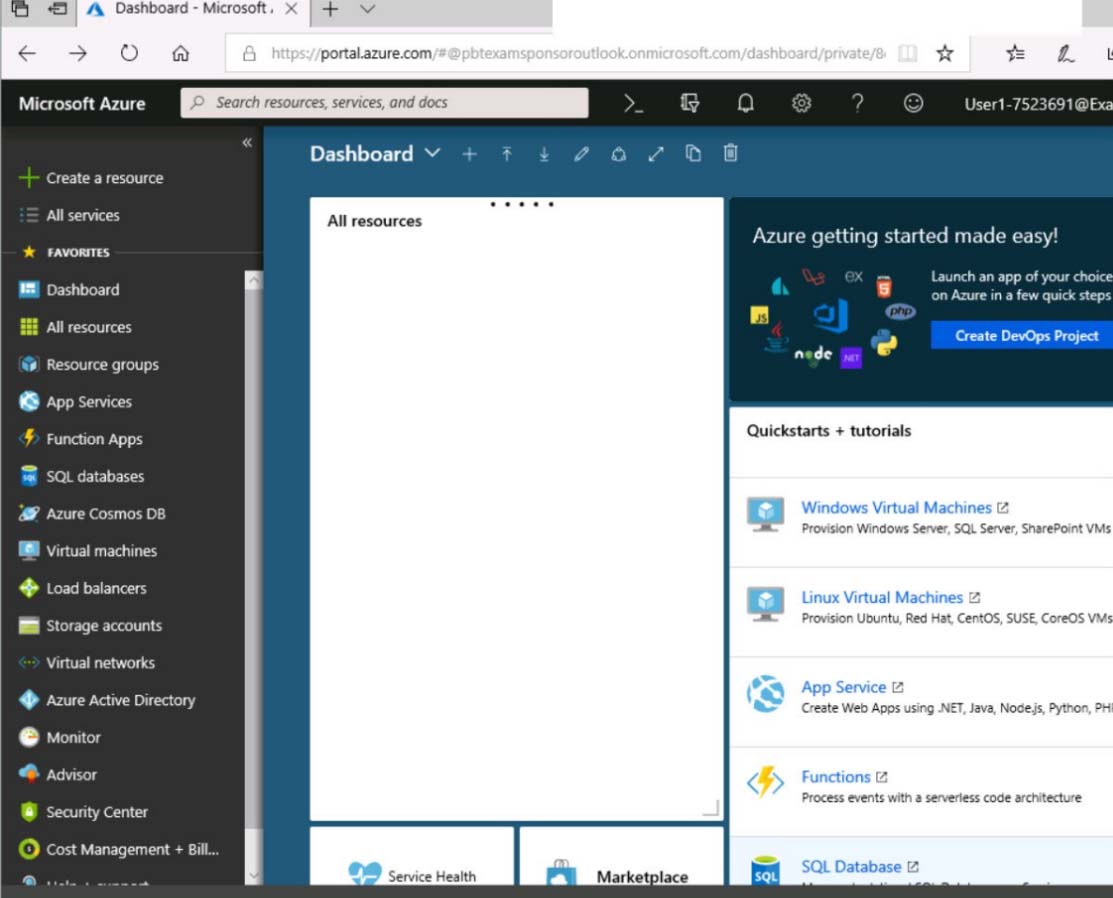
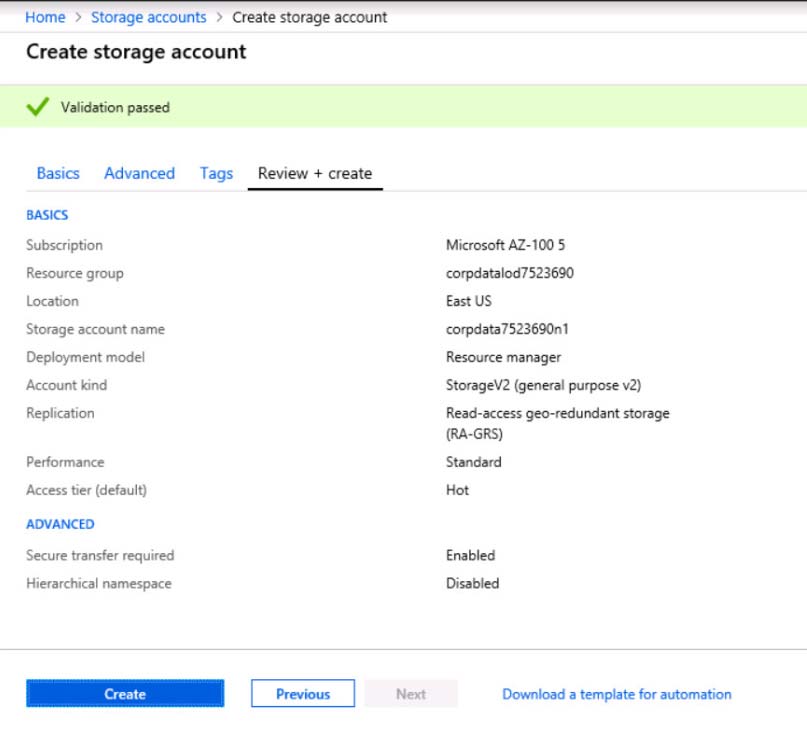
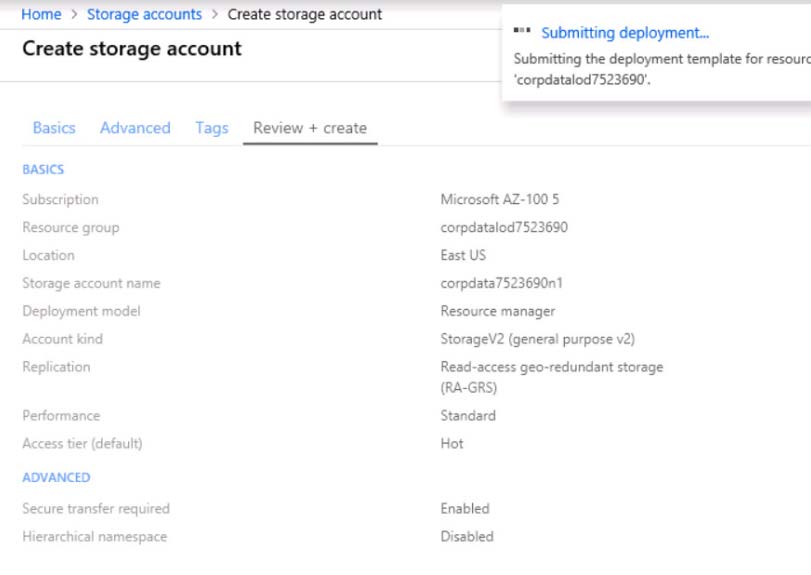
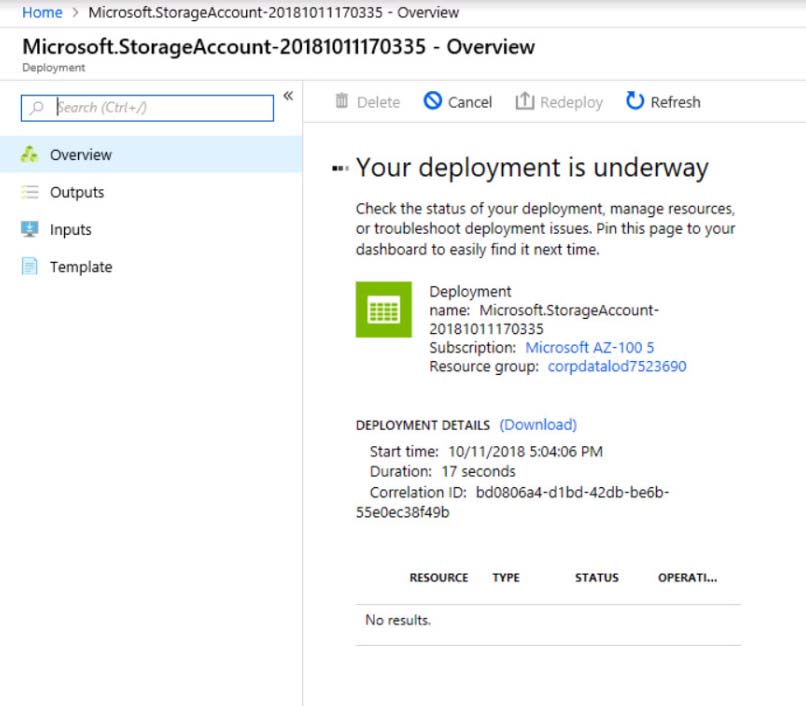
When you are finished performing all the tasks, click the "˜Next' button. Note that you cannot return to the lab once you click the "˜Next' button. Scoring occur in the background while you complete the rest of the exam. Overview - The following section of the exam is a lab. In this section, you will perform a set of tasks in a live environment. While most functionality will be available to you as it would be in a live environment, some functionality (e.g., copy and paste, ability to navigate to external websites) will not be possible by design. Scoring is based on the outcome of performing the tasks stated in the lab. In other words, it doesn't matter how you accomplish the task, if you successfully perform it, you will earn credit for that task. Labs are not timed separately, and this exam may have more than one lab that you must complete. You can use as much time as you would like to complete each lab. But, you should manage your time appropriately to ensure that you are able to complete the lab(s) and all other sections of the exam in the time provided. Please note that once you submit your work by clicking the Next button within a lab, you will NOT be able to return to the lab. To start the lab - You may start the lab by clicking the Next button. Your on-premises network uses an IP address range of 131.107.2.0 to 131.107.2.255. You need to ensure that only devices from the on-premises network can connect to the rg1lod8322490n1 storage account. What should you do from the Azure portal?
You have an Azure subscription named Subscription1 that contains an Azure virtual machine named VM1. VM1 is in a resource group named RG1. VM1 runs services that will be used to deploy resources to RG1. You need to ensure that a service running on VM1 can manage the resources in RG1 by using the identity of VM1. What should you do first?
A. From the Azure portal, modify the Access control (IAM) settings of RG1.
B. From the Azure portal, modify the Policies settings of RG1.
C. From the Azure portal, modify the Access control (IAM) settings of VM1.
D. From the Azure portal, modify the value of the Managed Service Identity option for VM1.
SIMULATION - Click to expand each objective. To connect to the Azure portal, type https://portal.azure.com in the browser address bar.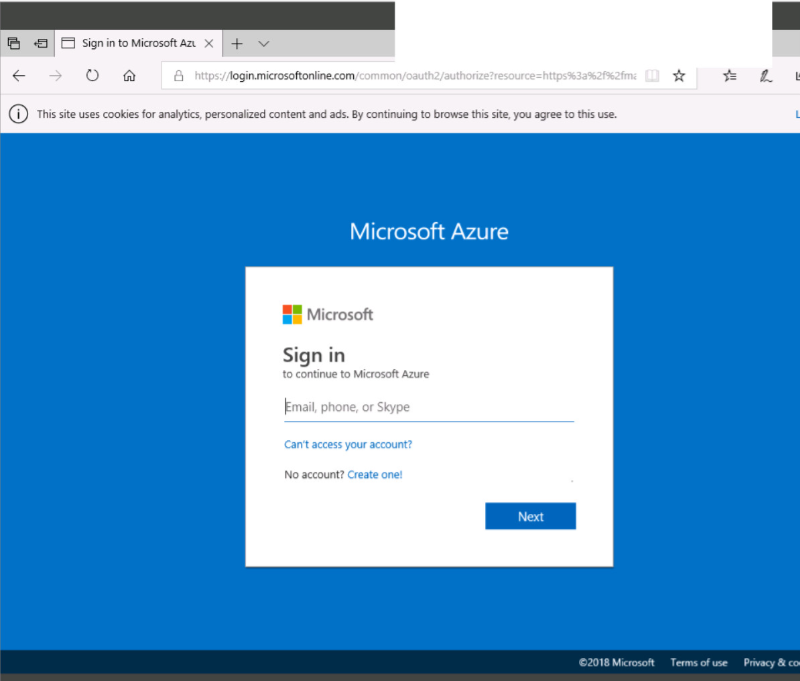
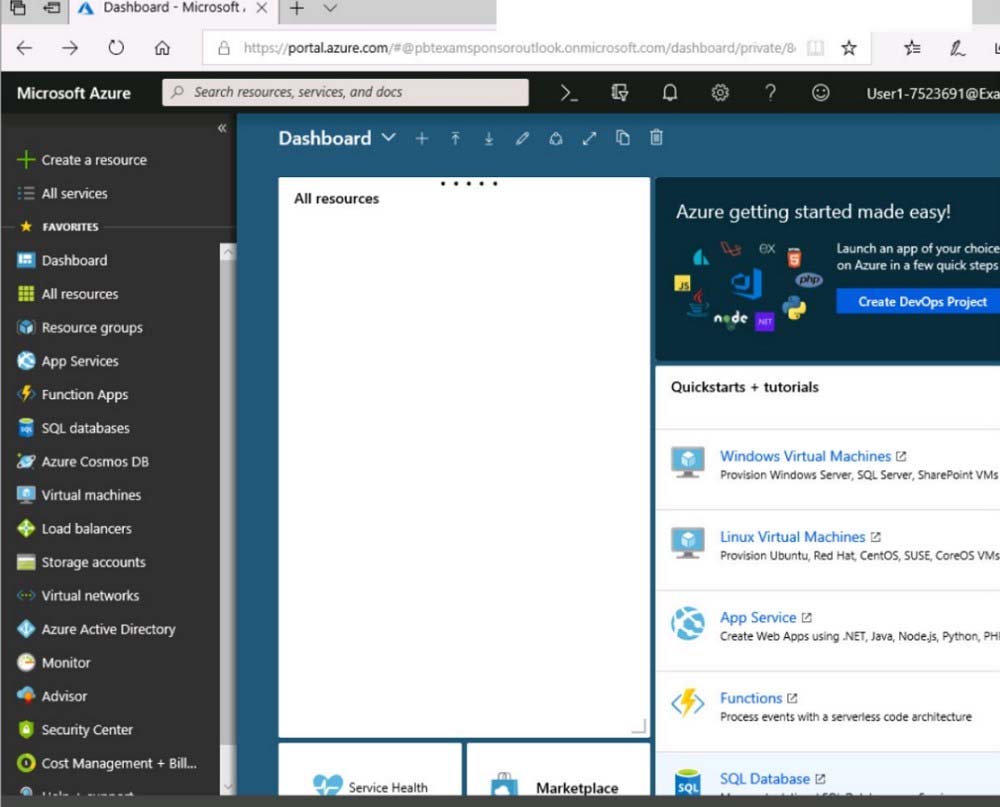
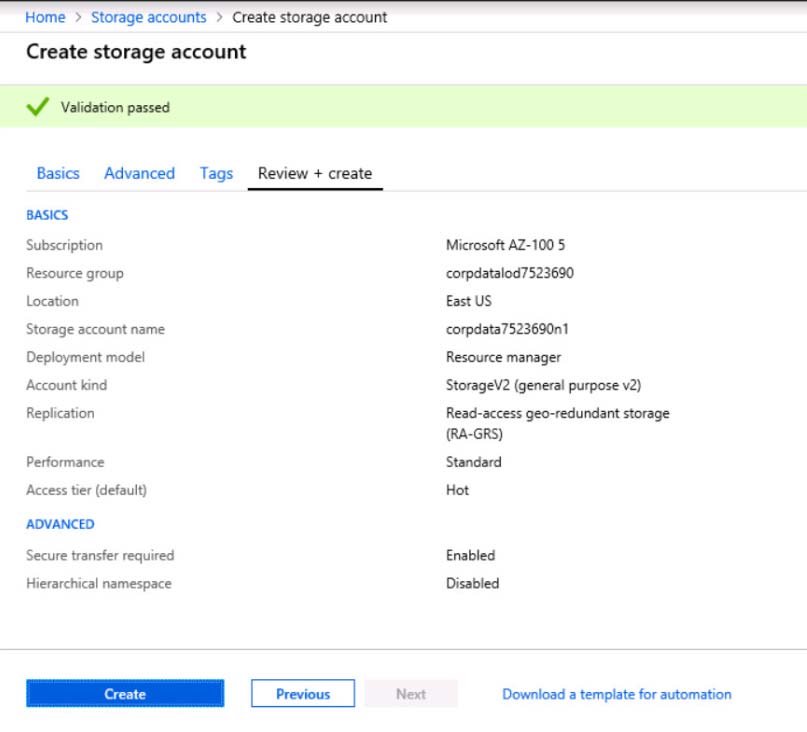

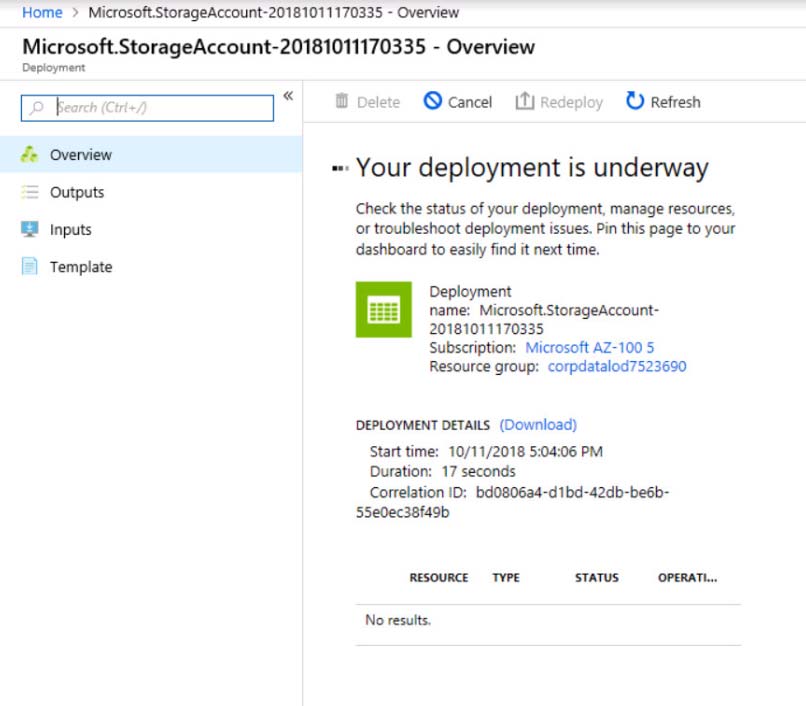
When you are finished performing all the tasks, click the "˜Next' button. Note that you cannot return to the lab once you click the "˜Next' button. Scoring occur in the background while you complete the rest of the exam. Overview - The following section of the exam is a lab. In this section, you will perform a set of tasks in a live environment. While most functionality will be available to you as it would be in a live environment, some functionality (e.g., copy and paste, ability to navigate to external websites) will not be possible by design. Scoring is based on the outcome of performing the tasks stated in the lab. In other words, it doesn't matter how you accomplish the task, if you successfully perform it, you will earn credit for that task. Labs are not timed separately, and this exam may have more than one lab that you must complete. You can use as much time as you would like to complete each lab. But, you should manage your time appropriately to ensure that you are able to complete the lab(s) and all other sections of the exam in the time provided. Please note that once you submit your work by clicking the Next button within a lab, you will NOT be able to return to the lab. To start the lab - You may start the lab by clicking the Next button. You need to create a function app named corp8548987n1 that supports sticky sessions. The solution must minimize the Azure-related costs of the App Service plan. What should you do from the Azure portal?
Note: This question is part of series of questions that present the same scenario. Each question in the series contains a unique solution that might meet the stated goals. Some question sets might have more than one correct solution, while others might not have a correct solution. After you answer a question in this section, you will NOT be able to return to it. As a result, these questions will not appear in the review screen. You have an Azure subscription. You have an on-premises file server named Server1 that runs Windows Server 2019. You manage Server1 by using Windows Admin Center. You need to ensure that if Server1 fails, you can recover the data from Azure. Solution: You create an Azure Storage account and an Azure Storage Sync service. You configure Azure File Sync for Server1. Does this meet the goal?
A. Yes
B. No
Note: This question is part of a series of questions that present the same scenario. Each question in the series contains a unique solution. Determine whether the solution meets the stated goals. You need to meet the vendor notification requirement. Solution: Update the Delivery API to send emails by using a Microsoft Office 365 SMTP server. Does the solution meet the goal?
A. Yes
B. No
You have an Azure subscription named Subscription1 that is used by several departments at your company. Subscription1 contains the resources in the following table.Another administrator deploys a virtual machine named VM1 and an Azure Storage account named Storage2 by using a single Azure Resource Manager template. You need to view the template used for the deployment. From which blade can you view the template that was used for the deployment?
A. Container1
B. VM1
C. Storage2
D. RG1
You set the multi-factor authentication status for a user named admin1@contoso.com to Enabled. Admin1 accesses the Azure portal by using a web browser. Which additional security verifications can Admin1 use when accessing the Azure portal?
A. an app password, a text message that contains a verification code, and a verification code sent from the Microsoft Authenticator app
B. a phone call, a text message that contains a verification code, and a notification or a verification code sent from the Microsoft Authenticator app
C. a phone call, an email message that contains a verification code, and a text message that contains an app password
D. an app password, a text message that contains a verification code, and a notification sent from the Microsoft Authenticator app
You develop an entertainment application where users can buy and trade virtual real estate. The application must scale to support thousands of users. The current architecture includes five Azure virtual machines (VM) that connect to an Azure SQL Database for account information and Azure Table Storage for backend services. A user interacts with these components in the cloud at any given time. ✑ Routing Service "" Routes a request to the appropriate service and must not persist data across sessions. ✑ Account Service "" Stores and manages all account information and authentication and requires data to persist across sessions ✑ User Service "" Stores and manages all user information and requires data to persist across sessions. ✑ Housing Network Service "" Stores and manages the current real-estate economy and requires data to persist across sessions. ✑ Trade Service "" Stores and manages virtual trade between accounts and requires data to persist across sessions. Due to volatile user traffic, a microservices solution is selected for scale agility. You need to migrate to a distributed microservices solution on Azure Service Fabric. Solution: Create a Service Fabric Cluster with a stateful Reliable Service for Routing Service. Deploy a Guest Executable to Service Fabric for each component. Does the solution meet the goal?
A. Yes
B. No
DRAG DROP - You need to prepare the environment to ensure that the web administrators can deploy the web apps as quickly as possible. Which three actions should you perform in sequence? To answer, move the appropriate actions from the list of actions to the answer area and arrange them in the correct order. Select and Place:
You have an Azure subscription that contains the storage accounts shown in the following table.You enable Azure Advanced Threat Protection (ATP) for all the storage accounts. You need to identify which storage accounts will generate Azure ATP alerts. Which two storage accounts should you identify? Each correct answer presents part of the solution. NOTE: Each correct selection is worth one point.
A. storagecontoso1
B. storagecontoso2
C. storagecontoso3
D. storagecontoso4
E. storagecontoso5
You need to meet the security requirements. What should you use?
A. HTTP Strict Transport Security (HSTS)
B. Direct Line API
C. Multi-Factor Authentication (MFA)
D. Bot Framework Portal
E. Bot Framework authentication
DRAG DROP - You need to use an Azure logic app to receive a notification when an administrator modifies the settings of a virtual machine in a resource group named RG1. Which three components should you create next in the Logic Apps Designer? To answer, move the appropriate components from the list of components to the answer area and arrange them in the correct order. Select and Place:
Note: This question is part of series of questions that present the same scenario. Each question in the series contains a unique solution that might meet the stated goals. Some question sets might have more than one correct solution, while others might not have a correct solution. After you answer a question in this section, you will NOT be able to return to it. As a result, these questions will not appear in the review screen. You have an Azure Active Directory (Azure AD) tenant named contoso.com. A user named Admin1 attempts to create an access review from the Azure Active Directory admin center and discovers that the Access reviews settings are unavailable. Admin1 discovers that all the other Identity Governance settings are available. Admin1 is assigned the User administrator, Compliance administrator, and Security administrator roles. You need to ensure that the Admin1 can create access reviews in contoso.com. Solution: You consent to Azure AD Privileged Identity Management (PIM). Does this meet the goal?
A. Yes
B. No
You download an Azure Resource Manager template based on an existing virtual machine. The template will be used to deploy 100 virtual machines. You need to modify the template to reference an administrative password. You must prevent the password from being stored in plain text. What should you create to store the password?
A. an Azure Key Vault and an access policy.
B. an Azure Storage account and an access policy.
C. Azure Active Directory (AD) Identity Protection and an Azure policy.
D. a Recovery Services vault and a backup policy.
HOTSPOT - You have an Azure Storage accounts as shown in the following exhibit.Use the drop-down menus to select the answer choice that completes each statement based on the information presented in the graphic. NOTE: Each correct selection is worth one point. Hot Area:
You have an Azure subscription named Subscription1 that contains two Azure networks named VNet1 and VNet2. VNet1 contains a VPN gateway named VPNGW1 that uses static routing. There is a site-to-site VPN connection between your on-premises network and VNet1. On a computer named Client1 that runs Windows 10, you configure a point-to-site VPN connection to VNet1. You configure virtual network peering between VNet1 and VNet2. You verify that you can connect to VNet2 from the on-premises network. Client1 is unable to connect to VNet2. You need to ensure that you can connect Client1 to VNet2. What should you do?
A. Select Allow gateway transit on VNet1.
B. Download and re-install the VPN client configuration package on Client1.
C. Enable BGP on VPNGW1.
D. Select Allow gateway transit on VNet2.
HOTSPOT - You have several Azure virtual machines on a virtual network named VNet1. You configure an Azure Storage account as shown in the following exhibit.Use the drop-down menus to select the answer choice that completes each statement based on the information presented in the graphic. NOTE: Each correct selection is worth one point. Hot Area:
HOTSPOT - You need to implement App2 to meet the application requirements. What should you include in the implementation? To answer, select the appropriate options in the answer area. NOTE: Each correct selection is worth one point. Hot Area:
A company is migrating an existing on-premises third-party website to Azure. The website is stateless. The company does not have access to the source code for the website. They have the original installer. The number of visitors at the website varies throughout the year. The on-premises infrastructure was resized to accommodate peaks but the extra capacity was not used. You need to implement a virtual machine scale set instance. What should you do -
A. Use a webhook to log autoscale failures.
B. Use an autoscale setting to scale instances vertically.
C. Use only default diagnostics metrics to trigger autoscaling
D. Use an autoscale setting to define more profiles that have one or more autoscale rules.
Note: This question is part of series of questions that present the same scenario. Each question in the series contains a unique solution that might meet the stated goals. Some question sets might have more than one correct solution, while others might not have a correct solution. After you answer a question in this section, you will NOT be able to return to it. As a result, these questions will not appear in the review screen. You have an Azure Active Directory (Azure AD) tenant named Adatum and an Azure Subscription named Subscription1. Adatum contains a group named Developers. Subscription1 contains a resource group named Dev. You need to provide the Developers group with the ability to create Azure logic apps in the Dev resource group. Solution: On Subscription1, you assign the DevTest Labs User role to the Developers group. Does this meet the goal?
A. Yes
B. No
You have an Azure App Service API that allows users to upload documents to the cloud with a mobile device. A mobile app connects to the service by using REST API calls. When a new document is uploaded to the service, the service extracts the document metadata. Usage statistics for the app show significant increases in app usage. The extraction process is CPU-intensive. You plan to modify the API to use a queue. You need to ensure that the solution scales, handles request spikes, and reduces costs between request spikes. What should you do?
A. Configure a CPU Optimized virtual machine (VM) and install the Web App service on the new instance.
B. Configure a series of CPU Optimized virtual machine (VM) instances and install extraction logic to process a queue.
C. Move the extraction logic into an Azure Function. Create a queue triggered function to process the queue.
D. Configure Azure Container Service to retrieve items from a queue and run across a pool of virtual machine (VM) nodes using the extraction logic.
Note: This question is part of series of questions that present the same scenario. Each question in the series contains a unique solution that might meet the stated goals. Some question sets might have more than one correct solution, while others might not have a correct solution. After you answer a question in this section, you will NOT be able to return to it. As a result, these questions will not appear in the review screen. You have an Azure subscription. You have an on-premises file server named Server1 that runs Windows Server 2019. You manage Server1 by using Windows Admin Center. You need to ensure that if Server1 fails, you can recover the data from Azure. Solution: You create a Recovery Services vault and configure a backup by using Windows Server Backup. Does this meet the goal?
A. Yes
B. No
Note: This question is part of series of questions that present the same scenario. Each question in the series contains a unique solution that might meet the stated goals. Some question sets might have more than one correct solution, while others might not have a correct solution. After you answer a question in this section, you will NOT be able to return to it. As a result, these questions will not appear in the review screen. You have an Azure Active Directory (Azure AD) tenant that contains a group named Group1. You need to enable multi-factor authentication (MFA) for the users in Group1 only. Solution: From Multi-Factor Authentication, you select Bulk update, and you provide a CSV file that contains the members of Group1. Does this meet the goal?
A. Yes
B. No
You are creating an IoT solution using Azure Time Series Insights. You configure the environment to ensure that all data for the current year is available. What should you do?
A. Add a disaster recovery (DR) strategy.
B. Set a value for the Data retention time setting.
C. Change the pricing tier.
D. Create a reference data set.
Note: This question is part of series of questions that present the same scenario. Each question in the series contains a unique solution that might meet the stated goals. Some question sets might have more than one correct solution, while others might not have a correct solution. After you answer a question in this section, you will NOT be able to return to it. As a result, these questions will not appear in the review screen. You have an Azure Active Directory (Azure AD) tenant that contains a group named Group1. You need to enable multi-factor authentication (MFA) for the users in Group1 only. Solution: From the Azure portal, you configure an authentication method policy. Does this meet the goal?
A. Yes
B. No
You manage a solution in Azure that consists of a single application which runs on a virtual machine (VM). Traffic to the application has increased dramatically. The application must not experience any downtime and scaling must be dynamically defined. You need to define an auto-scale strategy to ensure that the VM can handle the workload. Which three options should you recommend? Each correct answer presents a complete solution. NOTE: Each correct selection is worth one point.
A. Deploy application automatic vertical scaling.
B. Create a VM availability set.
C. Create a VM scale set.
D. Deploy application automatic horizontal scaling.
E. Deploy a custom auto-scale implementation.
You have a virtual network named VNet1 as shown in the exhibit. (Click the Exhibit tab.)No devices are connected to VNet1. You plan to peer VNet1 to another virtual network named VNet2 in the same region. VNet2 has an address space of 10.2.0.0/16. You need to create the peering. What should you do first?
A. Add a gateway subnet to VNet1.
B. Create a subnet on VNet1 and VNet2
C. Modify the address space of VNet1
D. Configure a service endpoint on VNet2
HOTSPOT - You have an Azure subscription named Subscription1. Subscription1 contains the resources in the following table.In Azure, you create a private DNS zone named adatum.com. You set the registration virtual network to VNet2. The adatum.com zone is configured is shown in the following exhibit.
For each of the following statements, select Yes if the statement is true. Otherwise, select No. NOTE: Each correct selection is worth one point. Hot Area:
SIMULATION - Click to expand each objective. To connect to the Azure portal, type https://portal.azure.com in the browser address bar.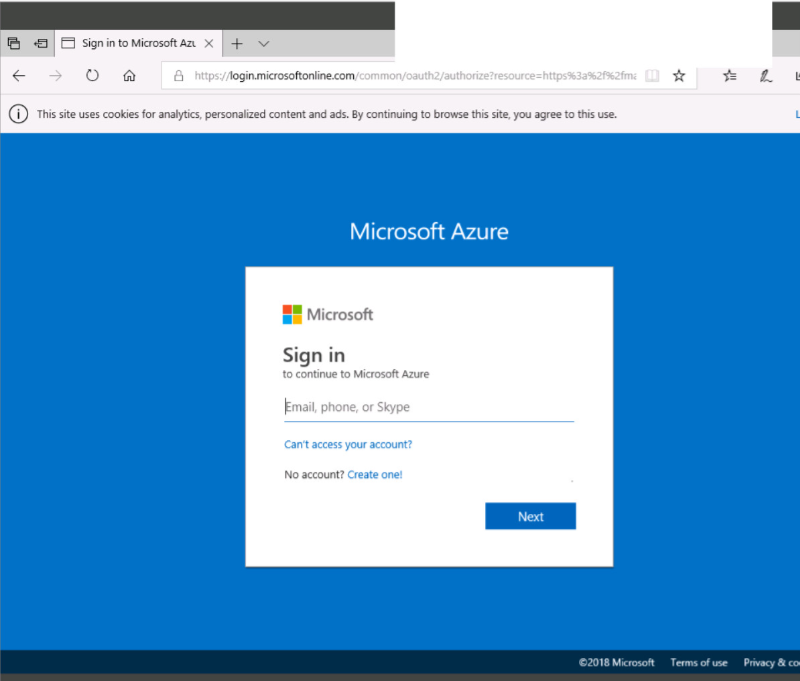

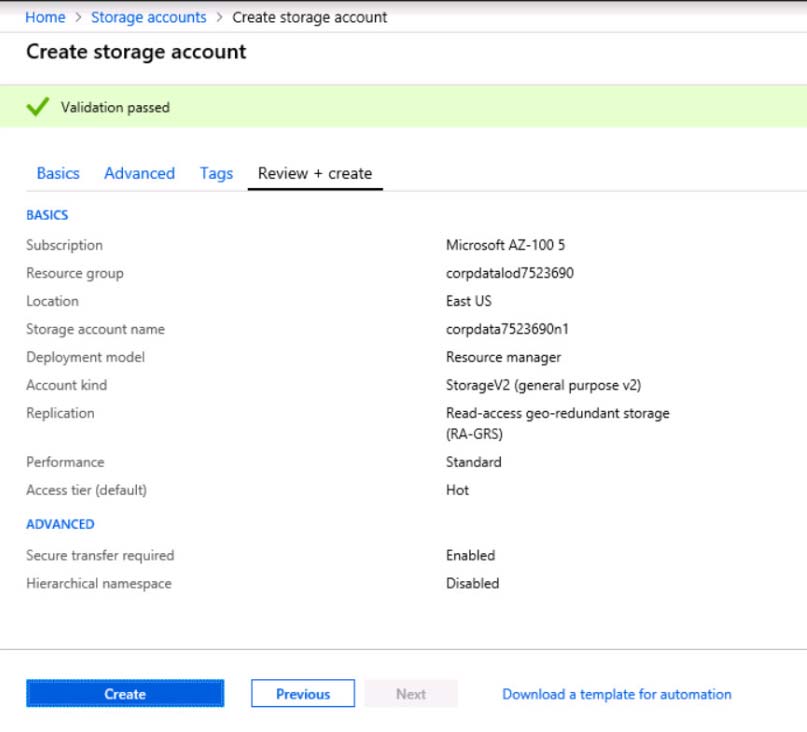
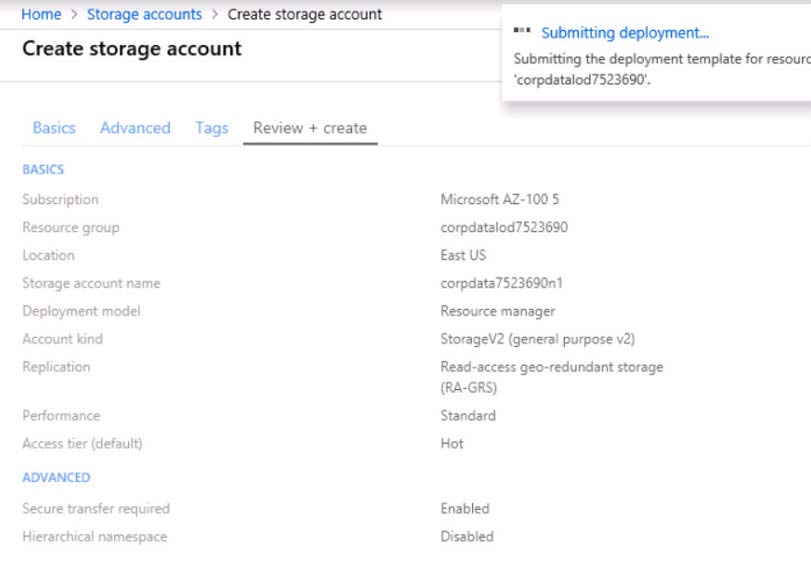
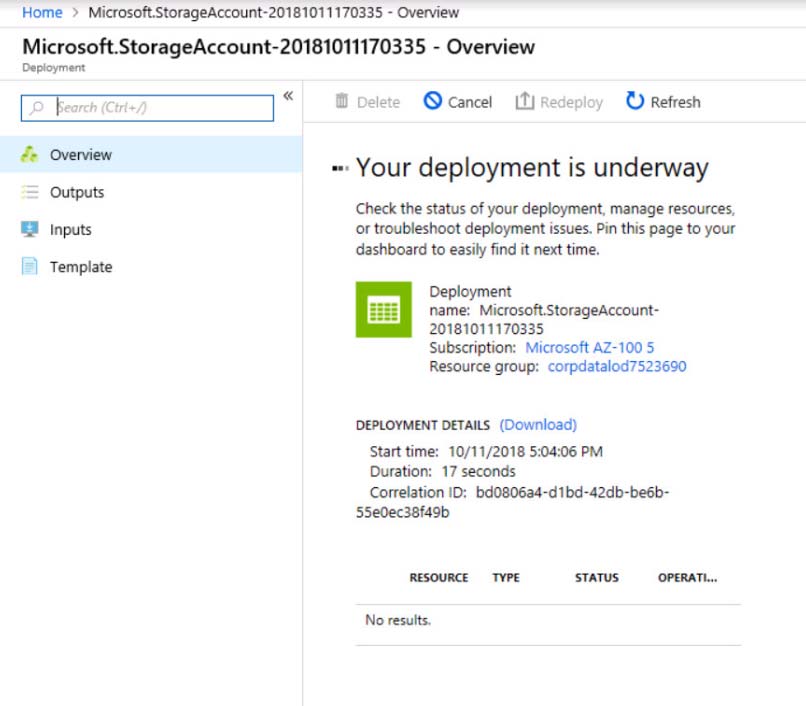
When you are finished performing all the tasks, click the "˜Next' button. Note that you cannot return to the lab once you click the "˜Next' button. Scoring occur in the background while you complete the rest of the exam. Overview - The following section of the exam is a lab. In this section, you will perform a set of tasks in a live environment. While most functionality will be available to you as it would be in a live environment, some functionality (e.g., copy and paste, ability to navigate to external websites) will not be possible by design. Scoring is based on the outcome of performing the tasks stated in the lab. In other words, it doesn't matter how you accomplish the task, if you successfully perform it, you will earn credit for that task. Labs are not timed separately, and this exam may have more than one lab that you must complete. You can use as much time as you would like to complete each lab. But, you should manage your time appropriately to ensure that you are able to complete the lab(s) and all other sections of the exam in the time provided. Please note that once you submit your work by clicking the Next button within a lab, you will NOT be able to return to the lab. To start the lab - You may start the lab by clicking the Next button. You plan to store media files in the rg1lod8322490 storage account. You need to configure the storage account to store the media files. The solution must ensure that only users who have access keys can download the media files and that the files are accessible only over HTTPS. What should you do from the Azure portal?
You create an Azure Time Series Insights event handler. You need to send data over the network as efficiently as possible and optimize query performance. What should you do?
A. Create a query plan
B. Send all properties
C. Use a Tag ID
D. Use reference data
You need to meet the technical requirement for VM4. What should you create and configure?
A. an Azure Logic App
B. an Azure Service Bus
C. an Azure Notification Hub
D. an Azure Event Hub
SIMULATION - Click to expand each objective. To connect to the Azure portal, type https://portal.azure.com in the browser address bar.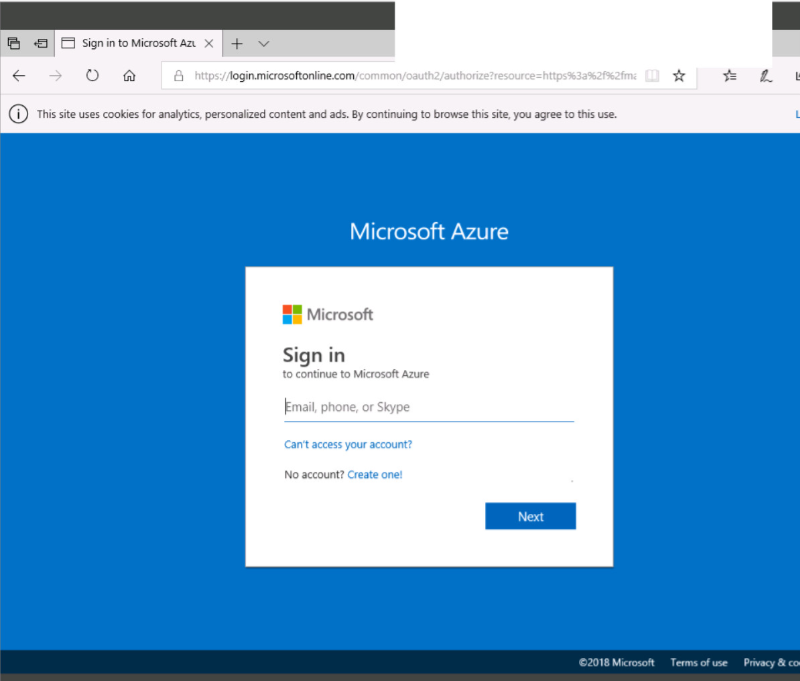
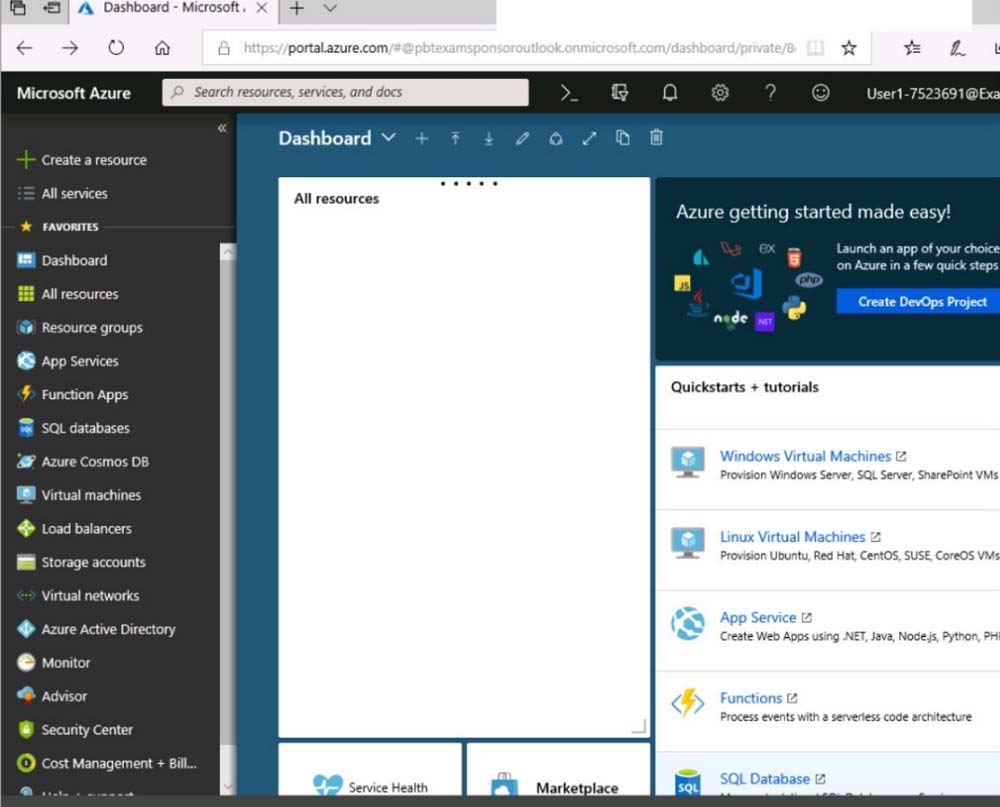

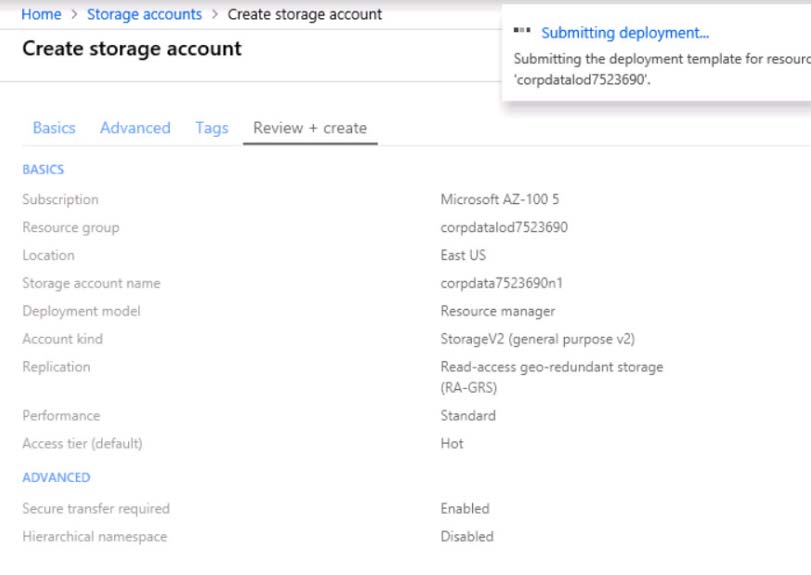
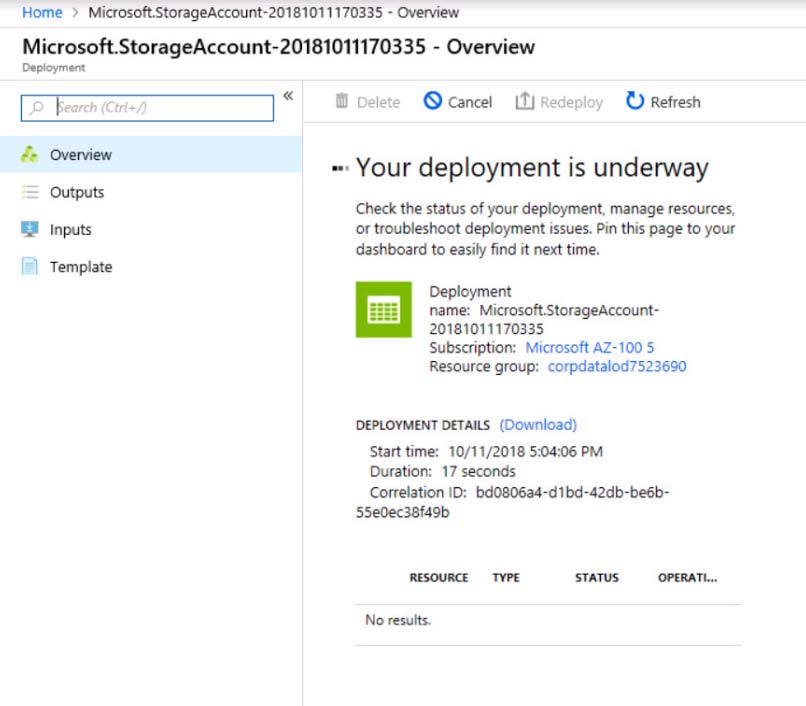
When you are finished performing all the tasks, click the "˜Next' button. Note that you cannot return to the lab once you click the "˜Next' button. Scoring occur in the background while you complete the rest of the exam. Overview - The following section of the exam is a lab. In this section, you will perform a set of tasks in a live environment. While most functionality will be available to you as it would be in a live environment, some functionality (e.g., copy and paste, ability to navigate to external websites) will not be possible by design. Scoring is based on the outcome of performing the tasks stated in the lab. In other words, it doesn't matter how you accomplish the task, if you successfully perform it, you will earn credit for that task. Labs are not timed separately, and this exam may have more than one lab that you must complete. You can use as much time as you would like to complete each lab. But, you should manage your time appropriately to ensure that you are able to complete the lab(s) and all other sections of the exam in the time provided. Please note that once you submit your work by clicking the Next button within a lab, you will NOT be able to return to the lab. To start the lab - You may start the lab by clicking the Next button. You need to create a web app named corp8548987n2 than can be scaled horizontally. The solution must use the lowest possible pricing tier for the App Service plan. What should you do from the Azure portal?
HOTSPOT - You are evaluating the connectivity between the virtual machines after the planned implementation of the Azure networking infrastructure. For each of the following statements, select Yes if the statement is true. Otherwise, select No. Hot Area:
Free Access Full AZ-300 Practice Questions Free
Want more hands-on practice? Click here to access the full bank of AZ-300 practice questions free and reinforce your understanding of all exam objectives.
We update our question sets regularly, so check back often for new and relevant content.
Good luck with your AZ-300 certification journey!


